Despite their remote location in the High Desert of central Oregon, the Painted Hills are one of the most-visited natural attractions in the state. It’s a popular day trip destination from Bend, as well as a fantastic two-or-three-day road trip from Portland.
The Painted Hills are famous for their extraordinary colored stripes of yellow, gold, orange, red, and black, which are evidence of subsequent eras of climate change, many millions of years ago.
This landscape is so unique, in fact, that it’s been designated as one of the 7 Wonders of Oregon, along with other iconic places like Mt. Hood, the Columbia River Gorge, and Crater Lake.
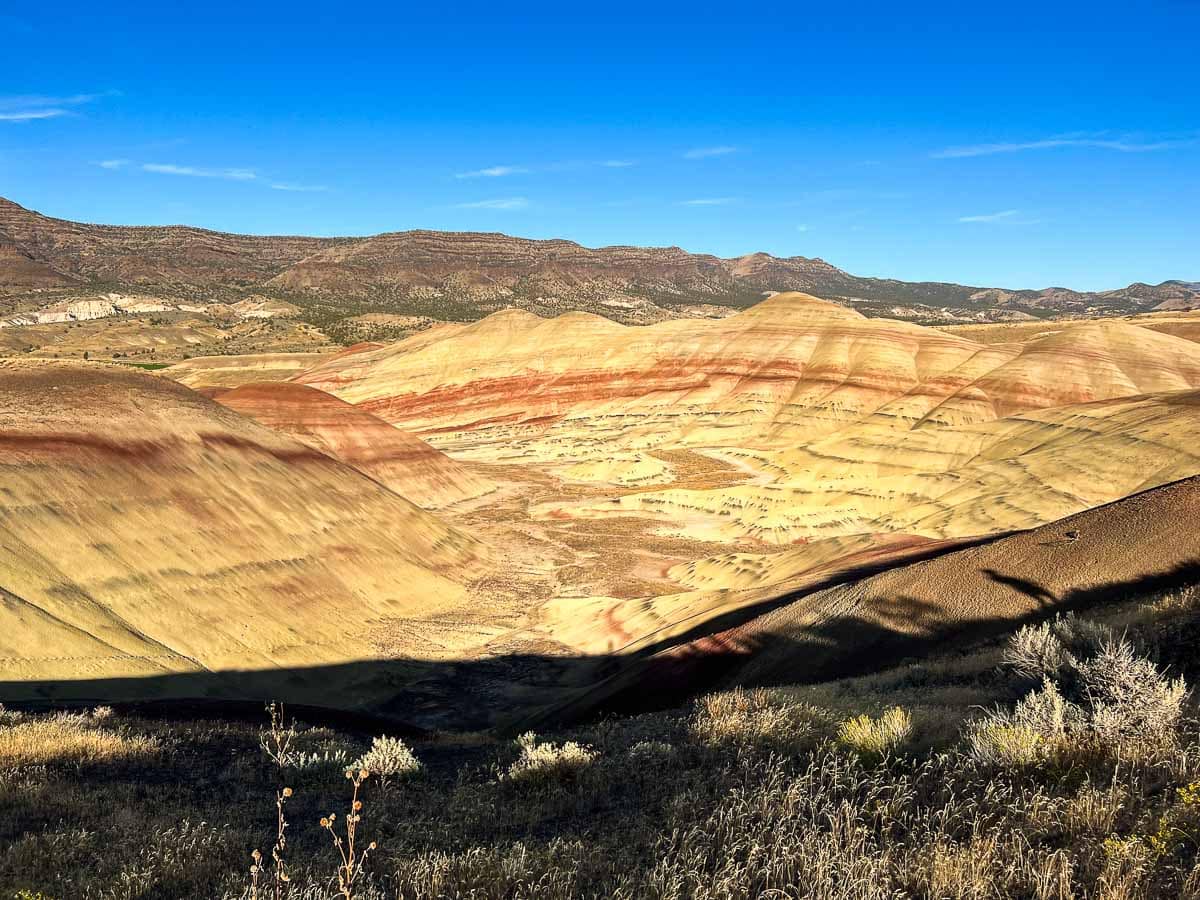
Featured in all self-respecting Oregon guidebooks and brochures, the Painted Hills are, indeed, a place that’s well worth visiting. However, there’s much more to this area than “just” these colored hills.
For starters, the Painted Hills are just one of three units that make up the amazing John Day Fossil Beds National Monument, one of the five National Park Services sites in Oregon.
The guide below will tell you all you need to know about visiting the Painted Hills Unit in Oregon’s John Day Fossil Beds National Monument.
Contents
- The Ultimate Guide to the Painted Hills Unit (John Day Fossil Beds National Monument)
- FAQs About Visiting Oregon’s Painted Hills (John Day Fossil Beds National Monument)
- Where Are the Painted Hills in Oregon?
- How Were the Oregon Painted Hills Formed?
- What Is the Best Time to Visit the Painted Hills of Oregon?
- Is There an Entrance Fee at the Oregon Painted Hills?
- Can I Camp at the Painted Hills?
- Which Facilities Are Available at Oregon’s Painted Hills?
- Where Should I Stay When Visiting the Painted Hills and John Day Fossil Beds National Monument?
- Are There Any Dangerous Animals at the Painted Hills in Oregon?
- Can I Bring My Dog to the Painted Hills?
- What Are the Best Hikes at the Painted Hills?
- How Much Time Do I Need to Visit the Painted Hills Unit?
- Best Things to Do at the Painted Hills Unit (John Day Fossil Beds National Monument)
- Hiking Trail Map of the Painted Hills Unit (John Day Fossil Beds National Monument)
- More National Parks in the Pacific Northwest
The Ultimate Guide to the Painted Hills Unit (John Day Fossil Beds National Monument)
We’ll start with an FAQ section where you’ll find the answers to several common questions about the Painted Hills Unit, followed by an overview of the best things to do at the Oregon Painted Hills.
You’ll also find a few maps scattered throughout this blog post, which will hopefully help you get an even better understanding of this fascinating place—and where to go.
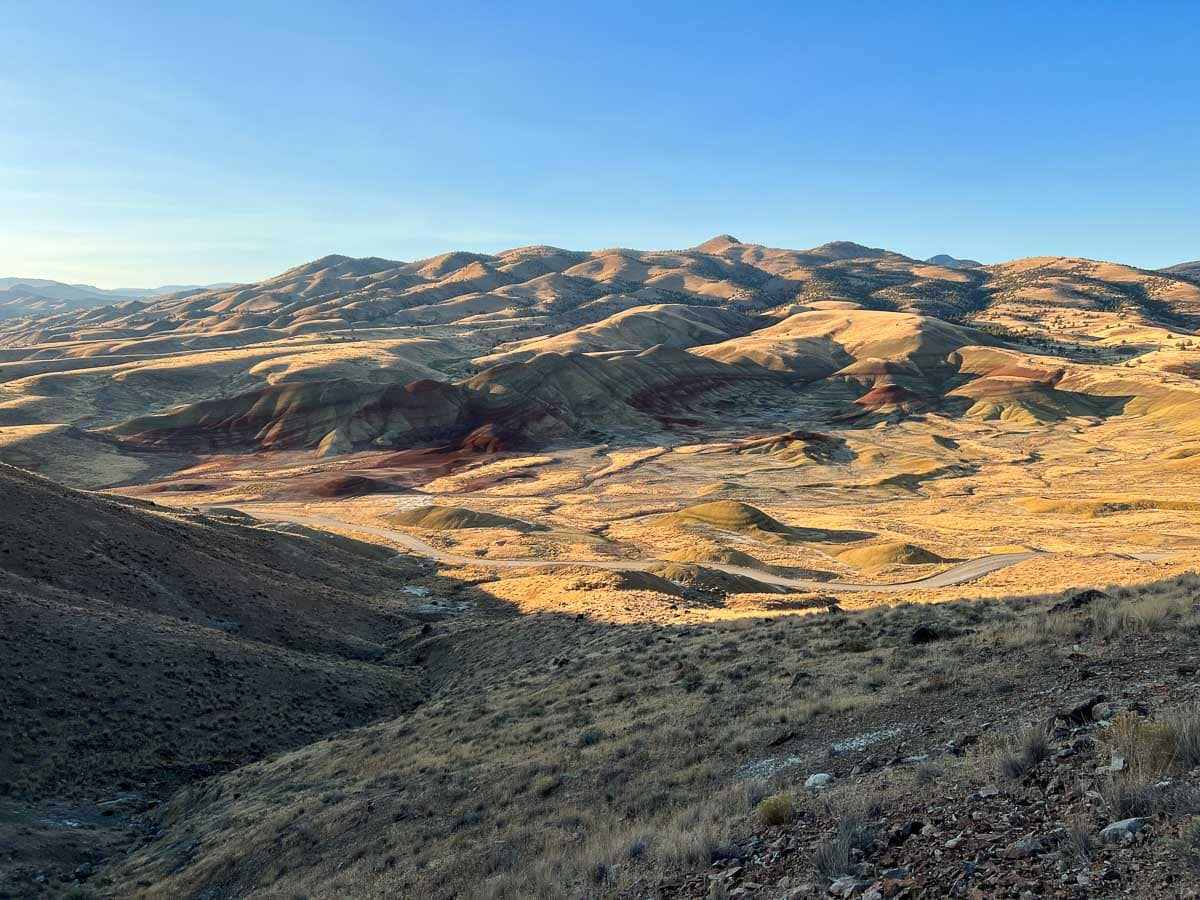
This blog post about the best things to do at the Painted Hills, Oregon, contains affiliate links. You can read more about our Terms of Use / Disclosure here.
FAQs About Visiting Oregon’s Painted Hills (John Day Fossil Beds National Monument)
Where Are the Painted Hills in Oregon?
The Painted Hills are the centerpiece of the Painted Hills Unit of John Day Fossil Beds National Monument. They are 10 miles to the northwest of the tiny town of Mitchell, in the heart of central Oregon’s High Desert.
Here are some general driving distances (and times) from nearby towns and major cities in Oregon:
- Mitchell to the Painted Hills: 10 miles (20 minutes)
- Prineville to the Painted Hills: 50 miles (1 hour)
- Redmond to the Painted Hills: 70 miles (1 hour 30 minutes)
- Bend to the Painted Hills: 85 miles (2 hours)
- The Dalles to the Painted Hills: 140 miles (3 hours)
- Hood River to the Painted Hills: 165 miles (3 hours 15 minutes)
- Salem to the Painted Hills: 200 miles (4 hours)
- Portland to the Painted Hills: 200 miles (4 hours)
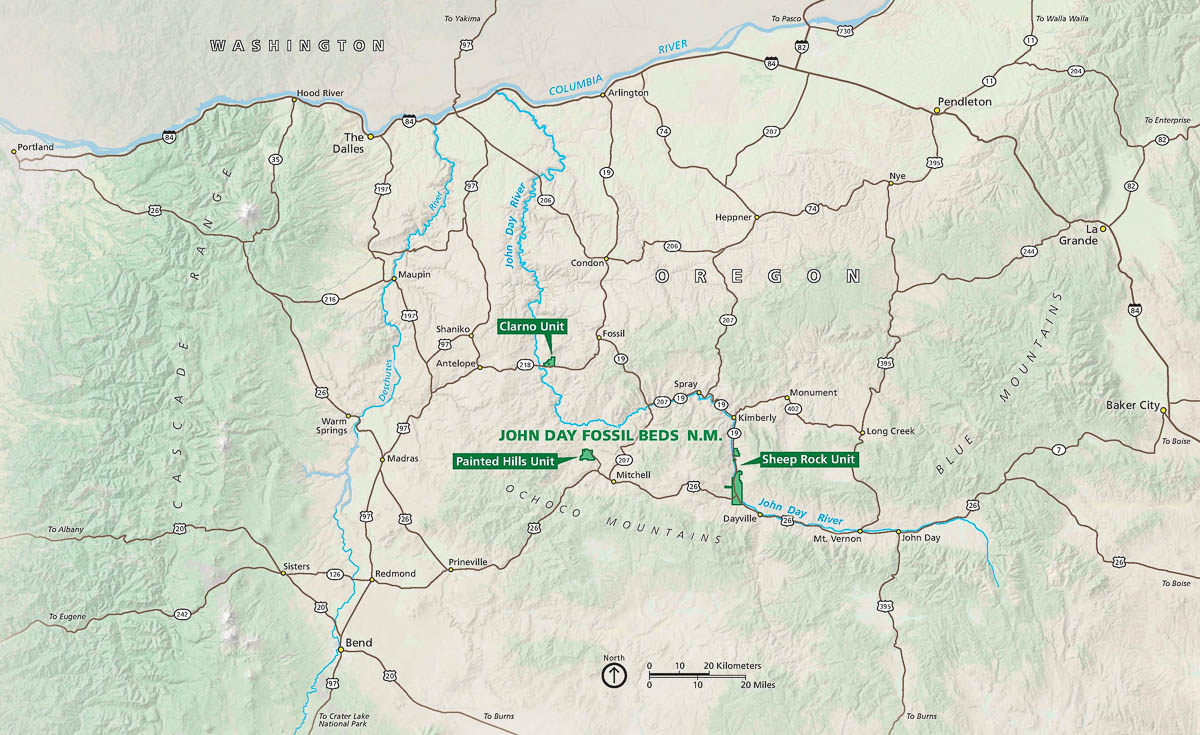
How Were the Oregon Painted Hills Formed?
Looking at the Painted Hills effectively means staring back in time. These multi-colored rock layers represent different geological periods, each with its own climatic events and/or natural disasters.
“Each layer is a window into the past, preserving fossilized remains of plants and animals, both familiar and strange,” the National Park Service says.
Specifically, the Painted Hills span two main fossil layers: the Bridge Creek Flora and Turtle Cove.
Bridge Creek Flora
The Bridge Creek Flora documents major changes to Earth’s climate about 39-30 million years ago. The regional climate of what is now central Oregon cooled significantly, while precipitation patterns became more seasonal.
The lake-dotted region was home to sprawling ancient hardwood forests, whose leaves got buried by successive layers of volcanic sediments.
Along with the leaves of ancient alders, elms, oaks, maples, and dawn redwoods, other living things like fish, amphibians, insects, and birds were also buried.
The Bridge Creek Flora (and those small animals) are preserved in so-called paleosols (literally meaning “fossil soils”), which have bright colors, such as those in the Painted Hills.
Simply put, each colored layer at the Painted Hills marks a different geological period. They’re the result of volcanic ash deposits, followed by soil formation, which occurred over and over again.
The deep red paleosols of the Painted Hills were formed during the “extensive weathering of clay-rich floodplain soils that formed in mesic, or moist, environments.”
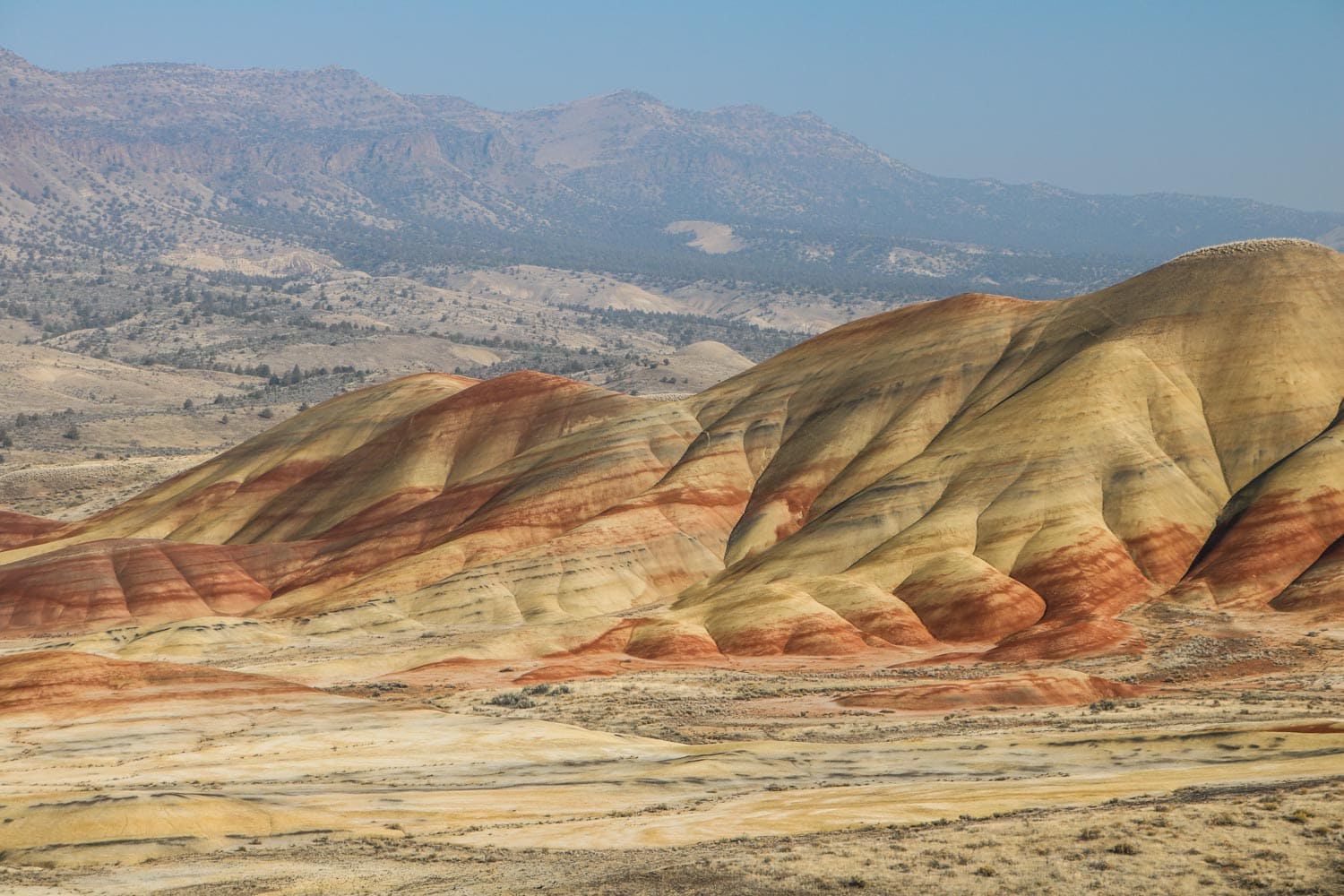
- Red/rust: Laterite soils rich in iron and aluminum, formed when the climate was humid and warm (lots of lakes and wetlands);
- Yellow/tan: Soils rich in iron and magnesium oxides, formed when the climate was drier and cooler (primarily hardwood forests);
- Black: Lignite soils (also known as “brown coal”) containing abundant plant materials that grew along the floodplain;
- Gray: Shale, siltstone and mudstone.
Turtle Cove Fauna
The Turtle Cove rock layers are younger than those of the Bridge Creek Flora, dating from 30-27 million years ago. This “is the thickest and most productive fossil-bearing layer within the John Day Fossil Beds,” according to the National Park Service.
That said, though, while Turtle Cove layers are present in the Painted Hills Unit, they don’t actually make up the Painted Hills themselves. These fossil-rich soils were created from ash and sediments spewed out by volcanoes hundreds of miles to the west.
Essentially, distant volcanic eruptions caused such devastation in this region that numerous animals were buried. The ash eventually turned into stone, which often has a striking blue-green color—which is attributed to a mineral known as celadonite.
Turtle Cove marks a period in time when the climate continued to get cooler and drier. The hardwood forests occasionally got pummeled by volcanic ash and pumice. Grasses gradually began to appear, as did several fascinating species of mammals.
The mammal fossils contained in the Turtle Cove layers include such remarkable species as three-toed horses, beavers, oreodonts, and mouse-deer.
A number of carnivores also called this region home at the time, notably nimravids, giant entelodonts, and bear-dogs.
What Is the Best Time to Visit the Painted Hills of Oregon?
All three units of John Day Fossil Beds National Monument, including the Painted Hills, are open 24/7, every day of the year.
That said, however, some seasons are better to visit the Painted Hills than others. Summer, for example, can be extremely hot in Oregon’s High Desert, while winter days may be snowy and icy.
The best times of year to visit the Painted Hills are late-spring and early-fall. Consider visiting in April, May, September, or October for the best weather, clear skies, and excellent hiking opportunities. I personally prefer the months of September and October.
In terms of the time of day, I strongly recommend visiting the Painted Hills at either sunrise or sunset—preferably both.
Sunrises are magical in this extraordinary landscape, while sunsets offer the most vibrant colors on the hills themselves. Watching the sunrise from the Carroll Rim Trail, for example, is unforgettable (see some photos below).
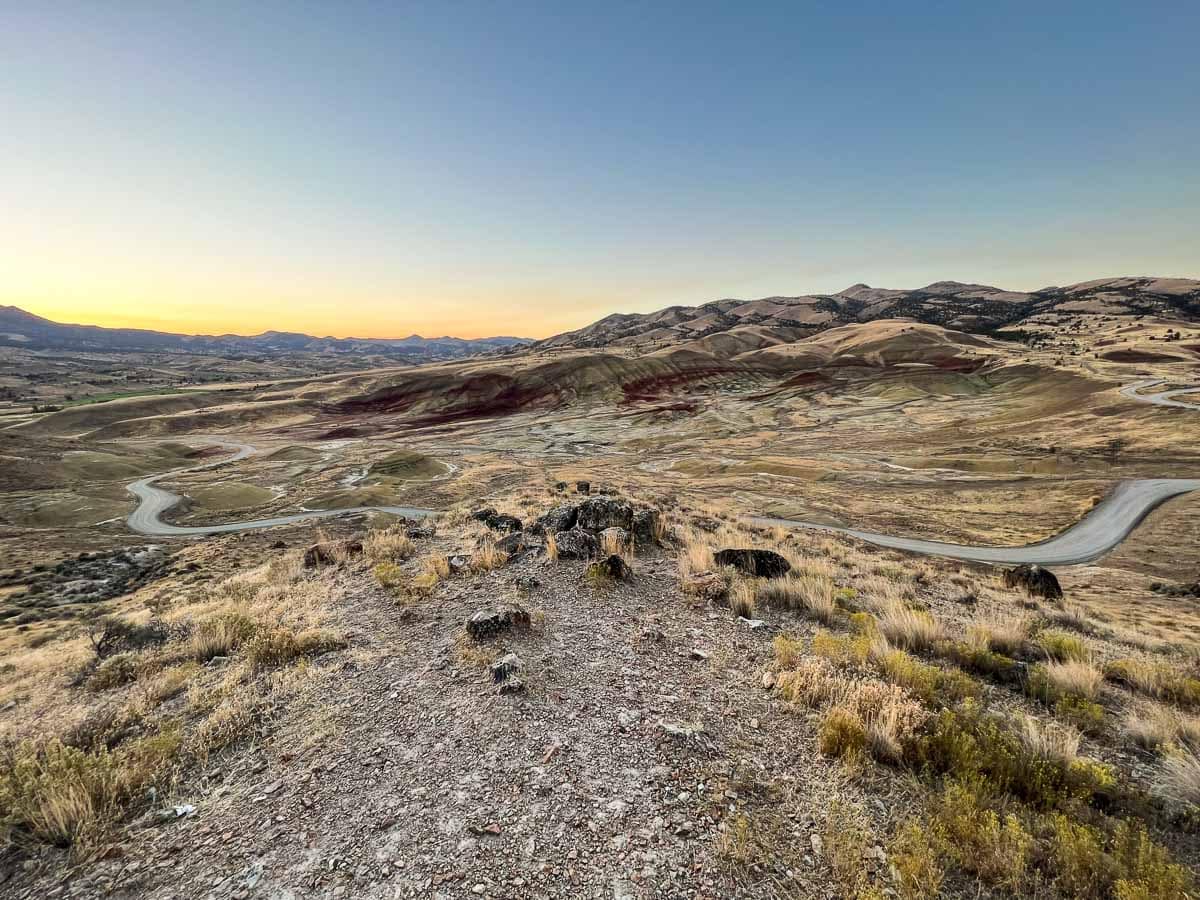
Is There an Entrance Fee at the Oregon Painted Hills?
No, the Painted Hills and the rest of John Day Fossil Beds National Monument are completely free to visit. There is no entrance fee.
Can I Camp at the Painted Hills?
No, there are no campgrounds in the Painted Hills Unit, nor in the other units of John Day Fossil Beds National Monument.
However, while camping isn’t allowed in the national monument, there are many campgrounds scattered throughout the region. Options range from dispersed camping on BLM lands to full-service campgrounds in towns.
Take a look at the map below for a general overview of the locations of campgrounds near the Painted Hills. You can also find information about those campgrounds here on the John Day Fossil Beds website.
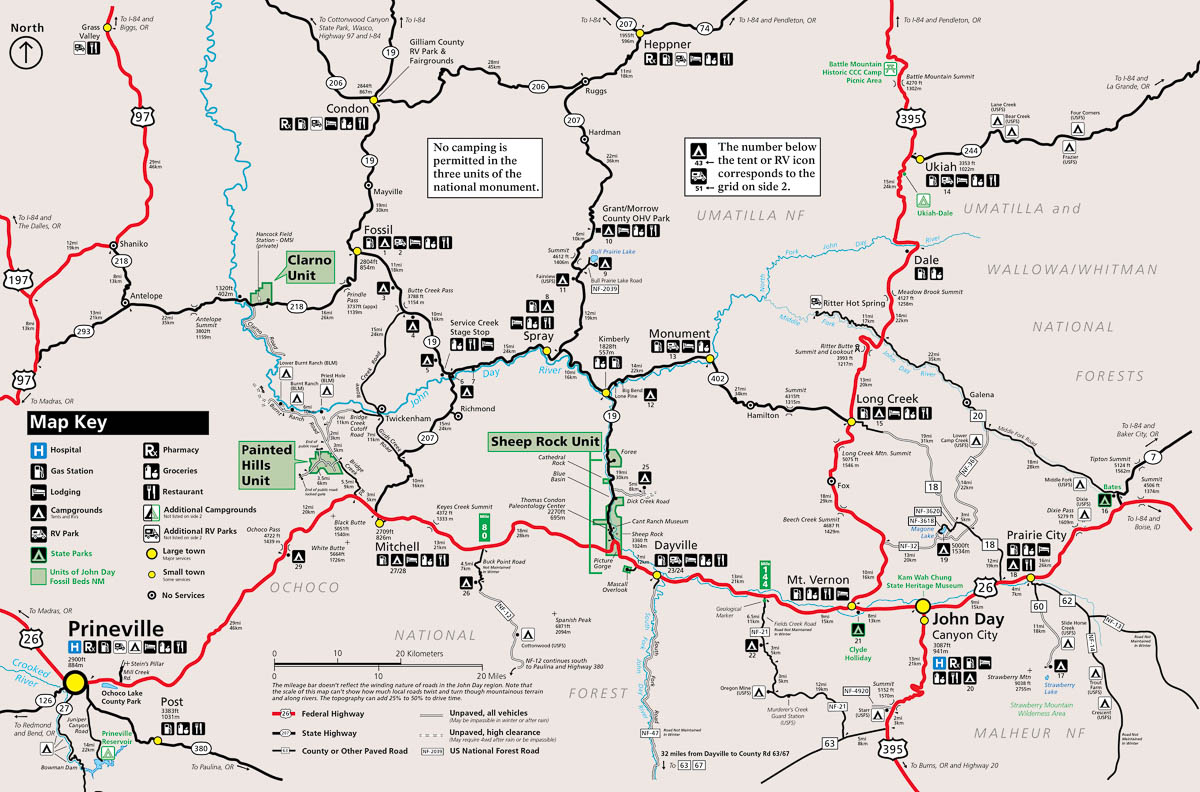
Which Facilities Are Available at Oregon’s Painted Hills?
Although the Painted Hills Unit is by far the most visit of all three units in John Day Fossil Beds National Monument, it doesn’t have many visitor facilities. The facilities available at the Painted Hills include:
- Picnic area;
- Restrooms;
- Information station; and
- Drinking water (available from Memorial Day to Labor Day).
The main visitor facility in the national monument is the state-of-the-art Thomas Condon Paleontology and Visitor Center. It’s located in the Sheep Rock Unit, about 1 hour’s drive (45 miles) from the Painted Hills.
Where Should I Stay When Visiting the Painted Hills and John Day Fossil Beds National Monument?
The nearest town to the Painted Hills is Mitchell, which is only 20 minutes (or 10 miles) to the southeast. This community is very small, but it has everything you might need to spend a few days at John Day Fossil Beds National Monument.
Accommodation options include the following:
I spent a couple of nights at the Little Pine Lodge and was very pleased with its amenities, spaciousness, and proximity to all other services in town.
CHECK ACCOMMODATION AVAILABILITY & RATES IN MITCHELL HERE.
Other places and services in Mitchell include a well-stocked grocery store, antique shop, a public park, small campground, public restrooms, and even a brewpub—the Tiger Town Brewing Company.
Additionally, there are a couple of fuel pumps (gasoline and diesel) right across the street from the Oregon Hotel and Little Pine Lodge. And yes, you can now pump your own gas in Oregon!
Are There Any Dangerous Animals at the Painted Hills in Oregon?
Yes, there are a number of potentially dangerous animals at the Painted Hills. Although it’s unlikely you’ll see them, it’s still important to be aware of their presence (and to know what to do if you encounter one).
Snakes
Most snake sightings at the Painted Hills are non-venomous bull snakes or garter snakes. There are, however, also two species of rattlesnakes—the prairie rattlesnake and northern Pacific rattlesnake.
Learn what to do when you encounter a rattlesnake here.
Scorpions
This semi-arid desert landscape is an optimal scorpion habitat, too. Scorpions in the John Day Fossil Beds are not considered deadly, but a sting might cause an allergic reaction or illness in some people.
These fascinating, small arachnids are rarely seen during the day, though, and are generally not a cause for concern.
Ticks
Adult ticks hang out on grasses and low vegetation, waiting until a person or animal brushes against the plant. Once they’ve transitioned from plant to mammal, they can spend a couple of hours looking for the ideal place to attach themselves.
There’s very little vegetation in the Painted Hills Unit where ticks might be found. The only notable exception is the picnic area, which does have a lush grassy area and streamside vegetation.
Learn about how to prevent tick bites here.
Spiders
One of North America’s three venomous spiders also lives in the John Day Fossil Beds—the black widow. They are quite venomous, but bites are very rare.
Black widows are usually found in holes in the ground, around tree stumps, under stones, on the exteriors of buildings, and in piles of leaves.
Mountain Lions
John Day Fossil Beds National Monument, including the Painted Hills, is home to mountain lions, which are also known as cougars or pumas. Actually seeing one of these large cats, let alone a close encounter, is exceedingly rare, though.
Yet, it’s still vitally important to know how to behave in mountain lion country. It’s advised, for instance, to hike in groups and keep kids and pets close.
In case of an encounter, never run from a mountain lion and make yourself as large as possible.
Learn what to do if you encounter a mountain lion here.
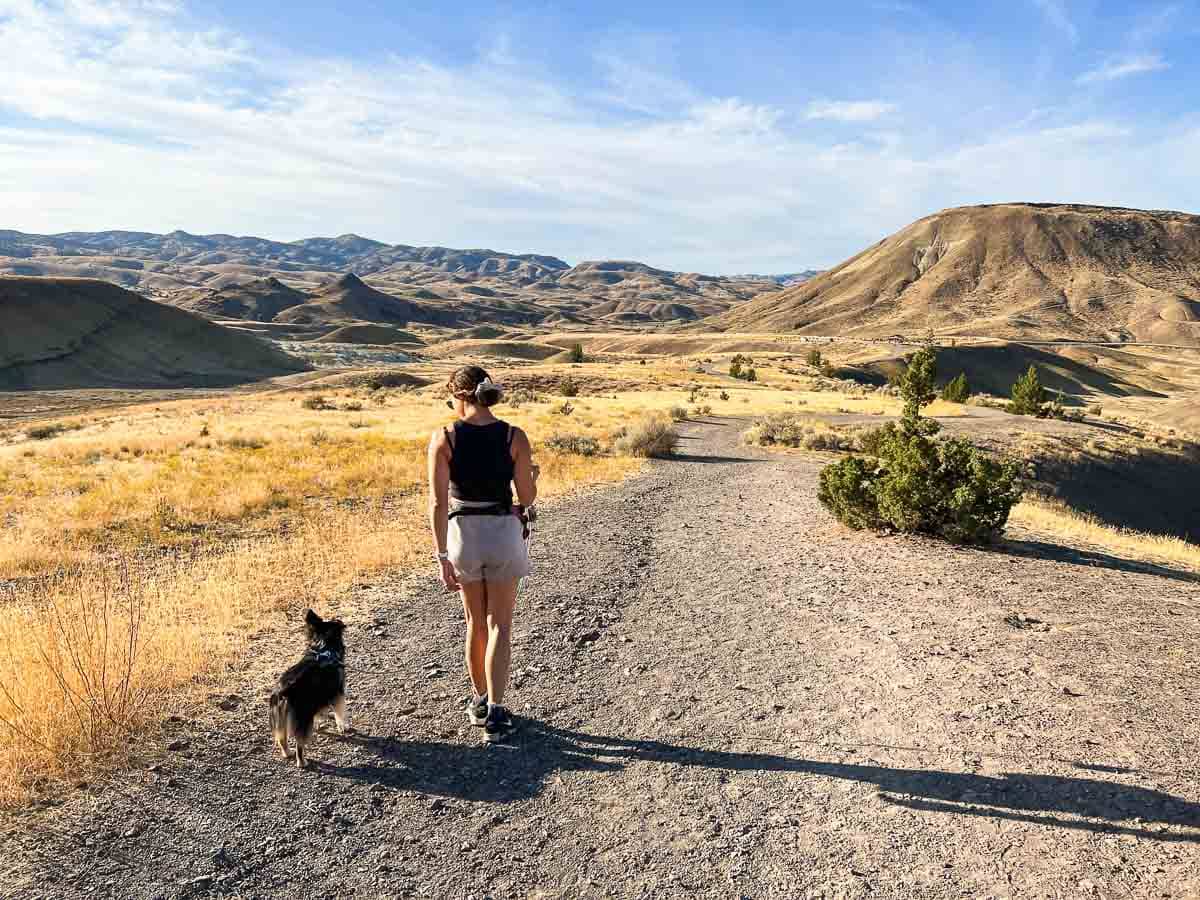
Can I Bring My Dog to the Painted Hills?
Yes, absolutely! Dogs are welcome almost everywhere in John Day Fossil Beds National Monument, including overlooks, picnic areas, and hiking trails.
They must be kept on a leash that’s no longer than 6 feet at all times. Note that dogs are not allowed within government buildings like the Thomas Condon Paleontology and Visitor Center.
What Are the Best Hikes at the Painted Hills?
The best way to explore the magnificent Painted Hills Unit is on foot.
There are five hiking trails in the Painted Hills Unit, ranging from 0.25 miles to 1.6 miles in length. I recommend hiking all of them. (I describe each trail in more detail below).
- Painted Hills Overlook Trail (0.5 miles, out and back)
- Carroll Rim Trail (1.6 miles, out and back)
- Painted Cove Trail (0.25 miles, loop)
- Leaf Hill Trail (0.25 miles, loop)
- Red Scar Knoll Trail (0.25 miles, out and back)
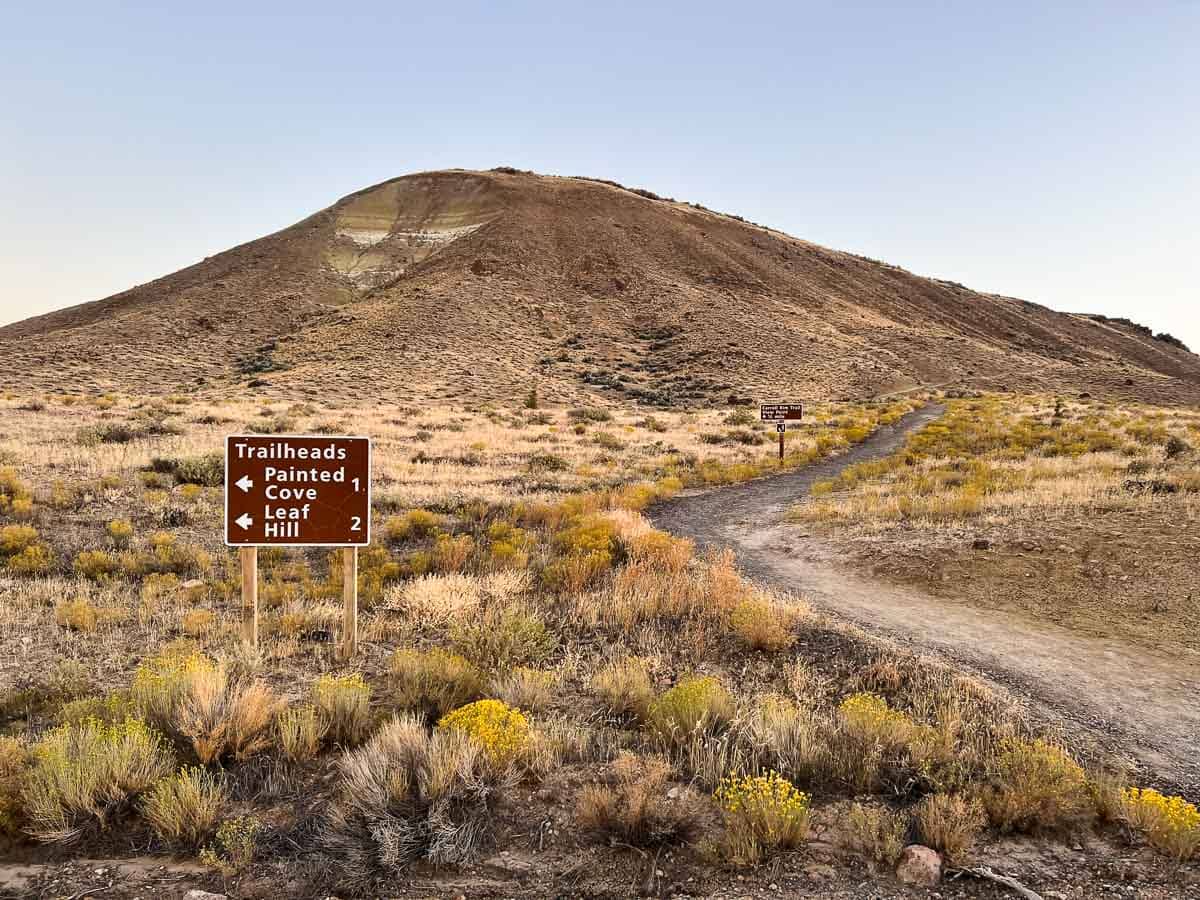
How Much Time Do I Need to Visit the Painted Hills Unit?
You could easily see the Painted Hills in under an hour, but I suggest dedicating one full day, including a sunrise and/or sunset, to this spectacular place.
The hills and the surrounding landscape are breathtaking at dawn and dusk, while mornings and evenings are the best (and coolest) time to hike the Painted Hills trails.
You could spend midday exploring other parts of the John Day Fossil Beds, particularly the Sheep Rock Unit and Thomas Condon Paleontology Center.
Therefore, I recommend spending two nights in the area—Mitchell is a great location—so that you can enjoy and appreciate these ancient landscapes to the fullest.
Best Things to Do at the Painted Hills Unit (John Day Fossil Beds National Monument)
Many visitors don’t venture beyond the Painted Hills themselves when visiting the Painted Hills Unit. I think that’s a huge mistake. While the Painted Hills are the obvious star attraction in the area, there’s a lot more to see and do here.
1. Enjoy Up-Close Views on the Painted Hills Overlook Trail
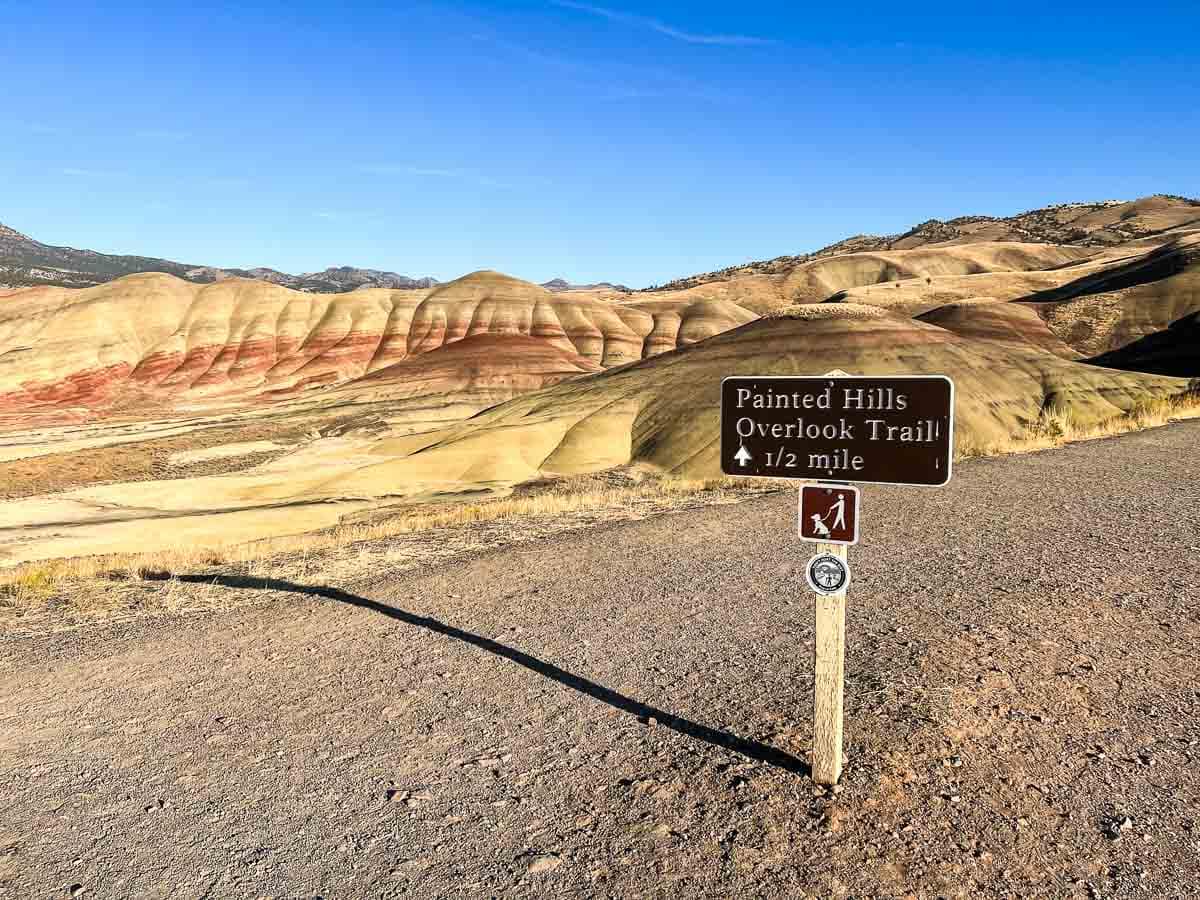

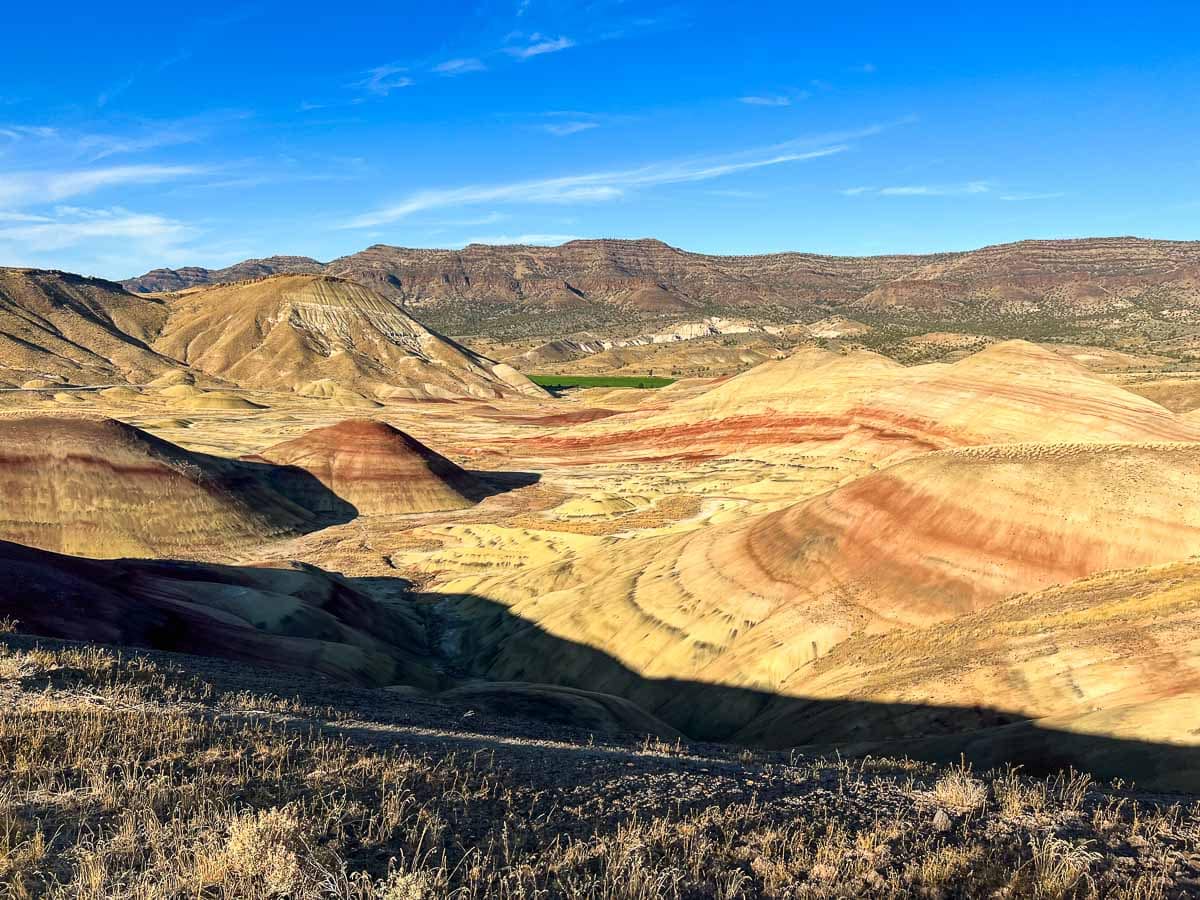
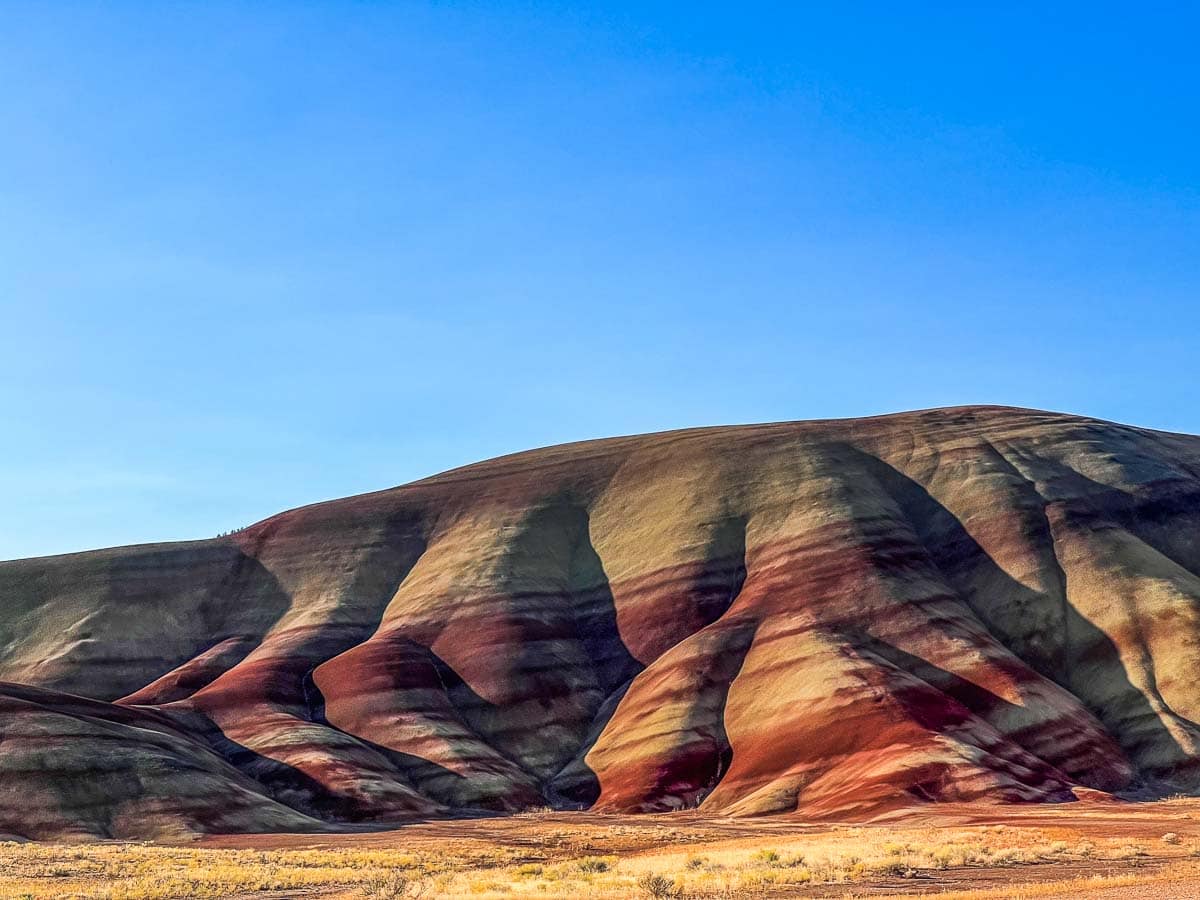
The Painted Hills Overlook Trail is the one hike that almost all visitors do. Only 0.5 miles long, it’s an easy and fairly flat trail that offers exceptional up-close views of the Painted Hills the entire way.
And those views truly are extraordinary. You can clearly see the yellow, golden, orange, red, and black layers that characterize the Painted Hills—and gave them their name.
Additionally, this is arguably the best place to watch the sunset at the Painted Hills and see their colored layers get even more vibrant.
2. Drive the Scenic Bear Creek Road
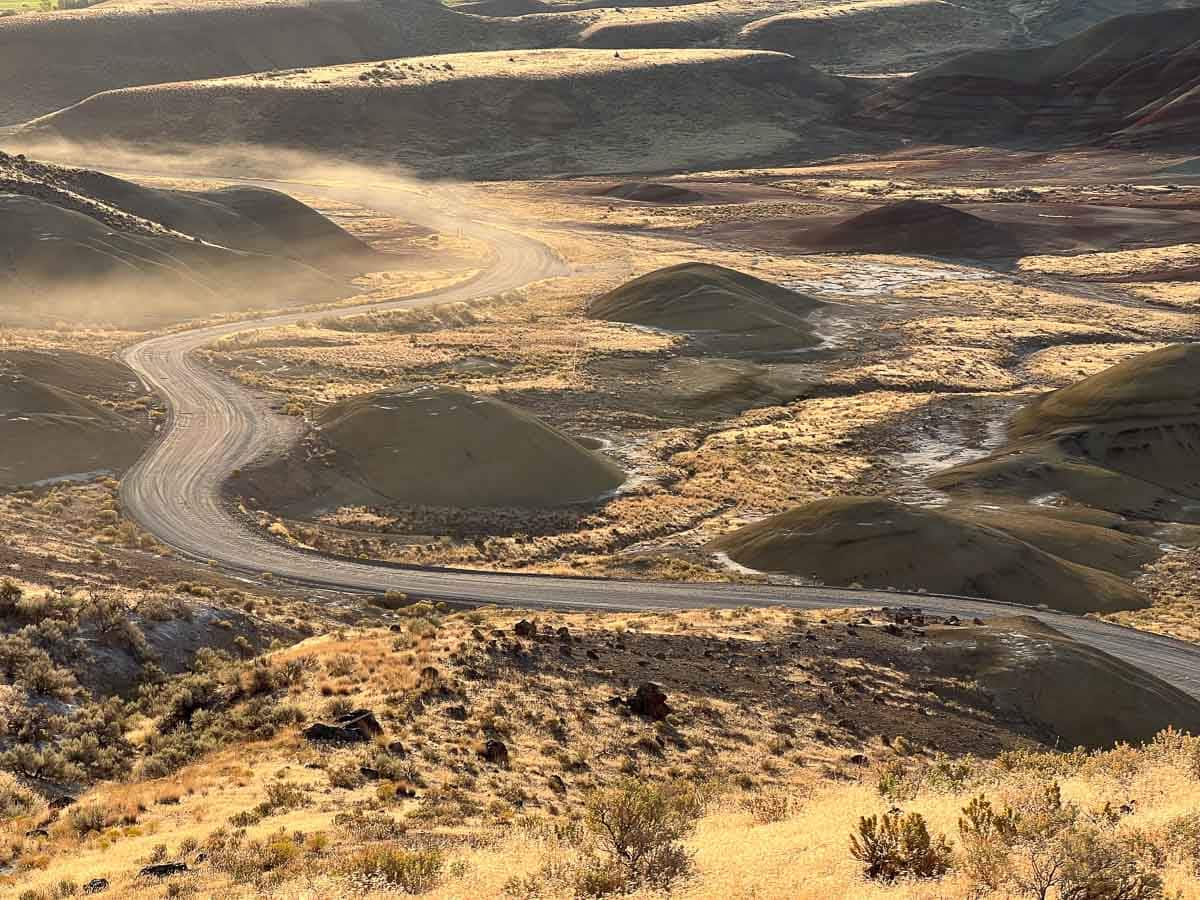
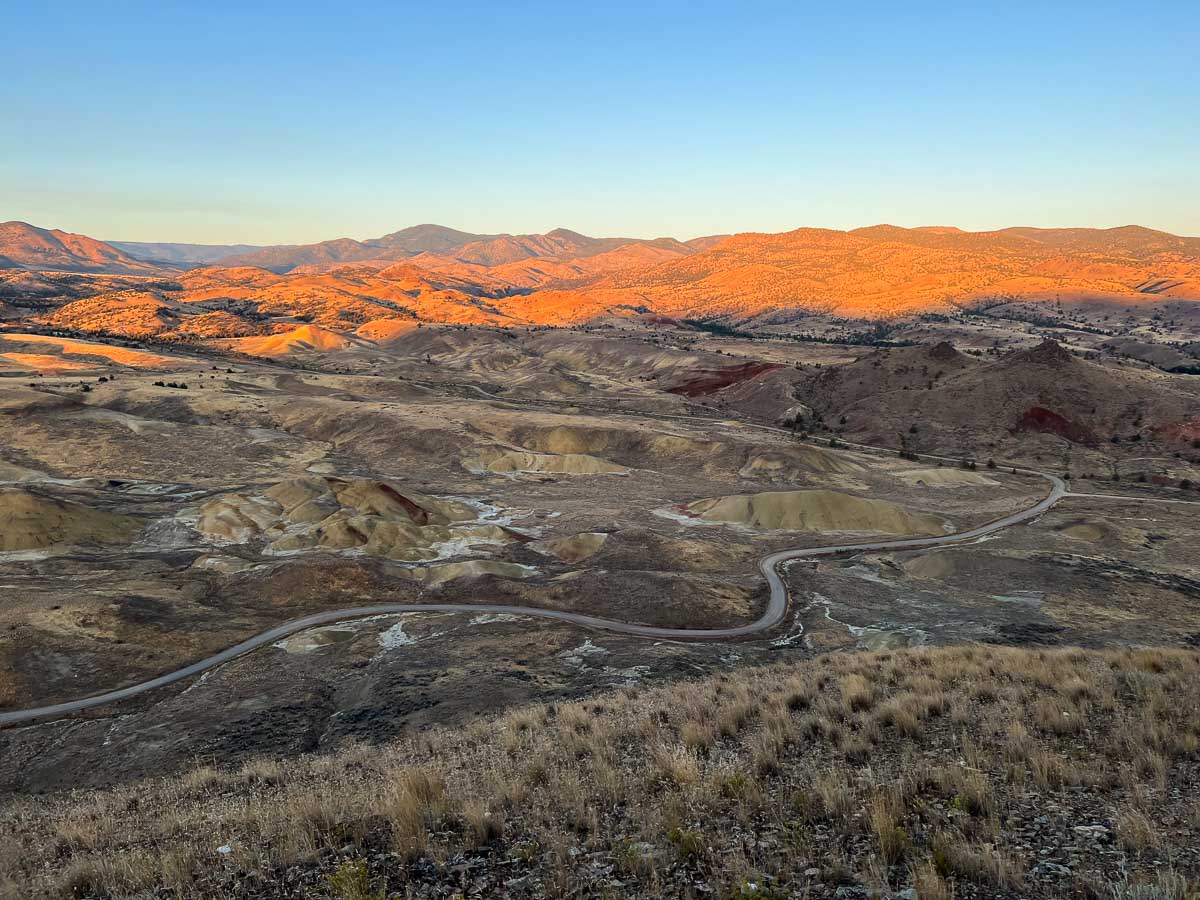
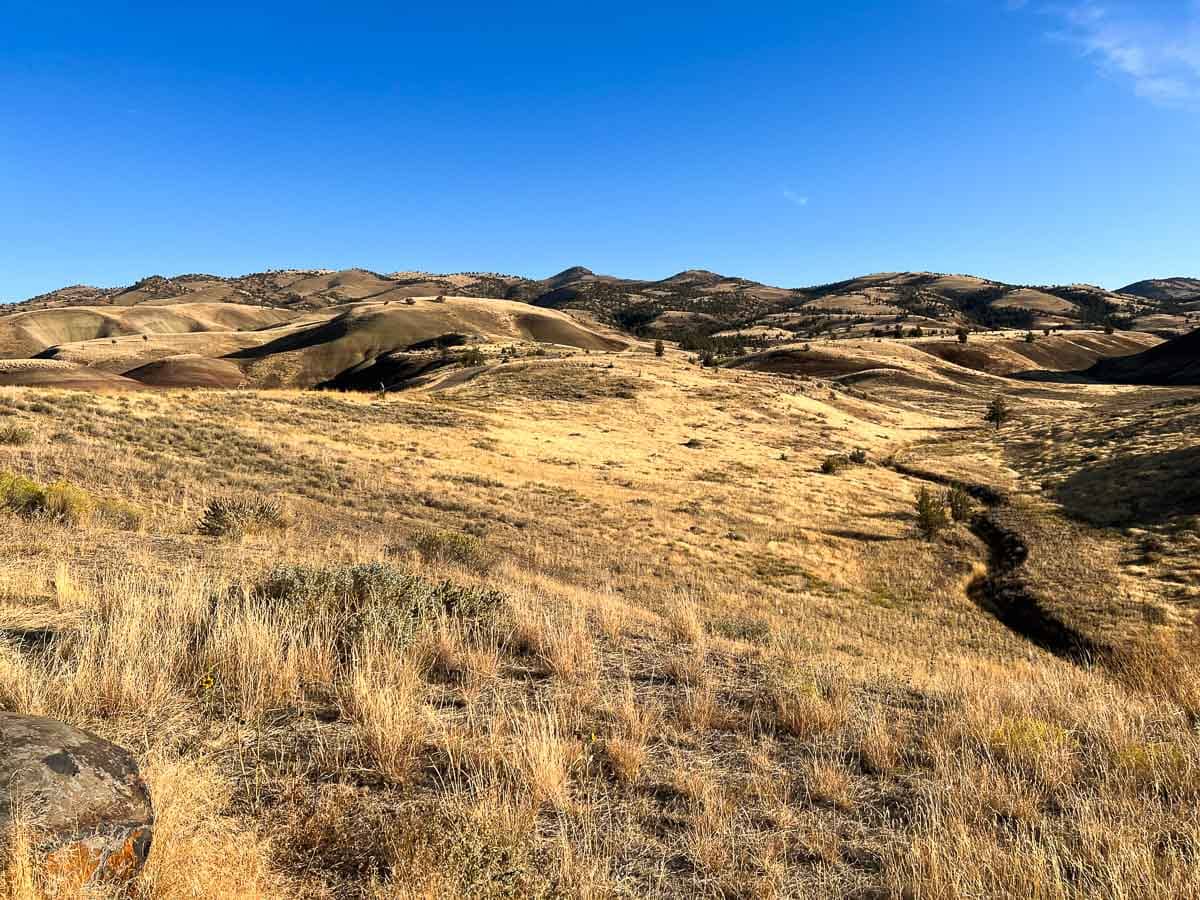
Bear Creek Road is the only public road through the Painted Hills Unit. It starts at the Painted Hills Unit entrance, off of Burnt Ranch Road, and runs to the Red Scar Knoll Trailhead.
All Painted Hills trails are along this beautiful 3.5-mile gravel road—except for the Painted Cove Trail, which is at the end of a short spur road.
See the map at the end of this article for a visual overview of Bear Creek Road in the Painted Hills Unit.
3. Explore the Picturesque Painted Cove Trail
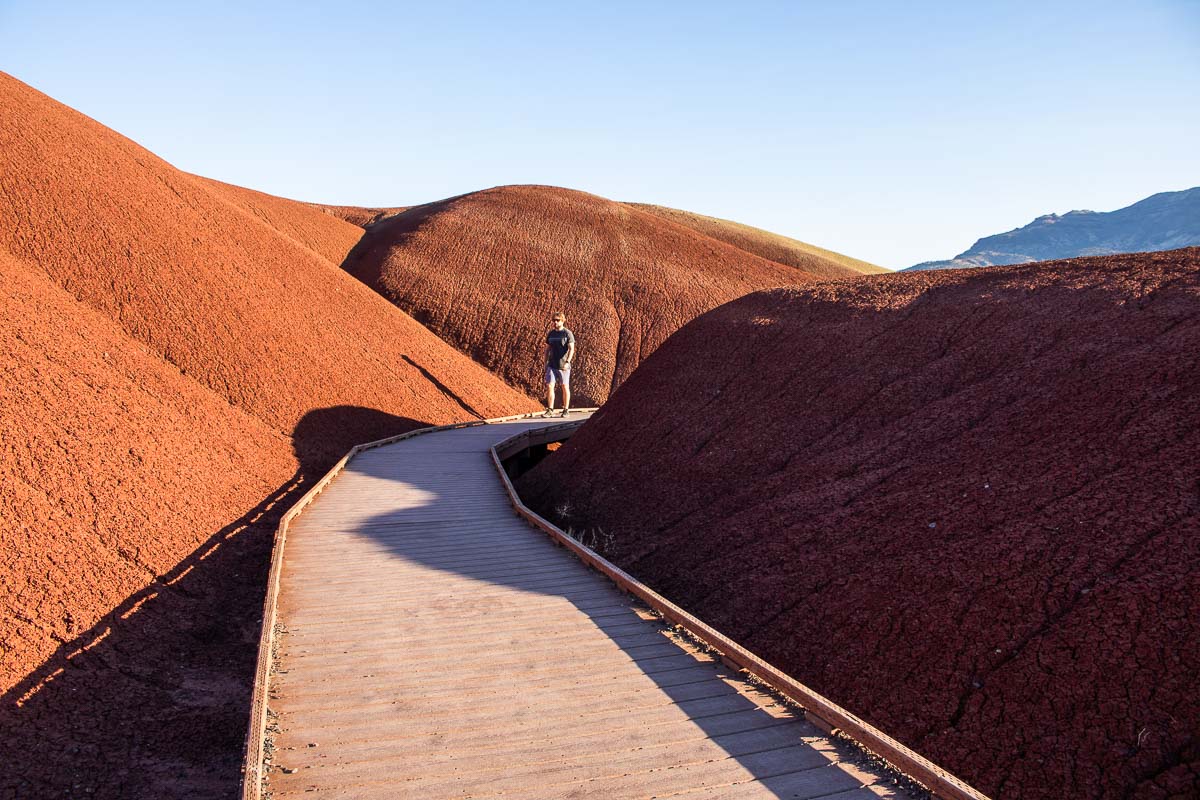
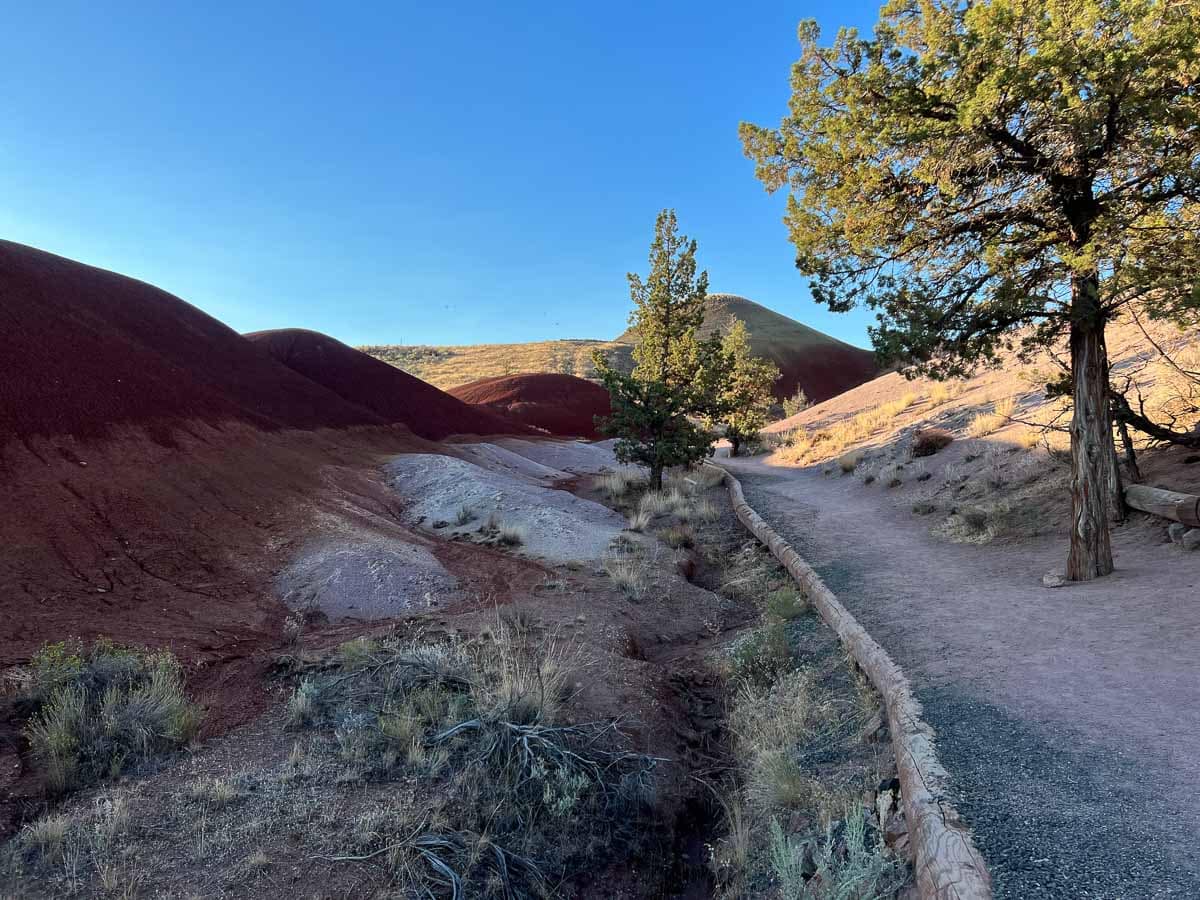
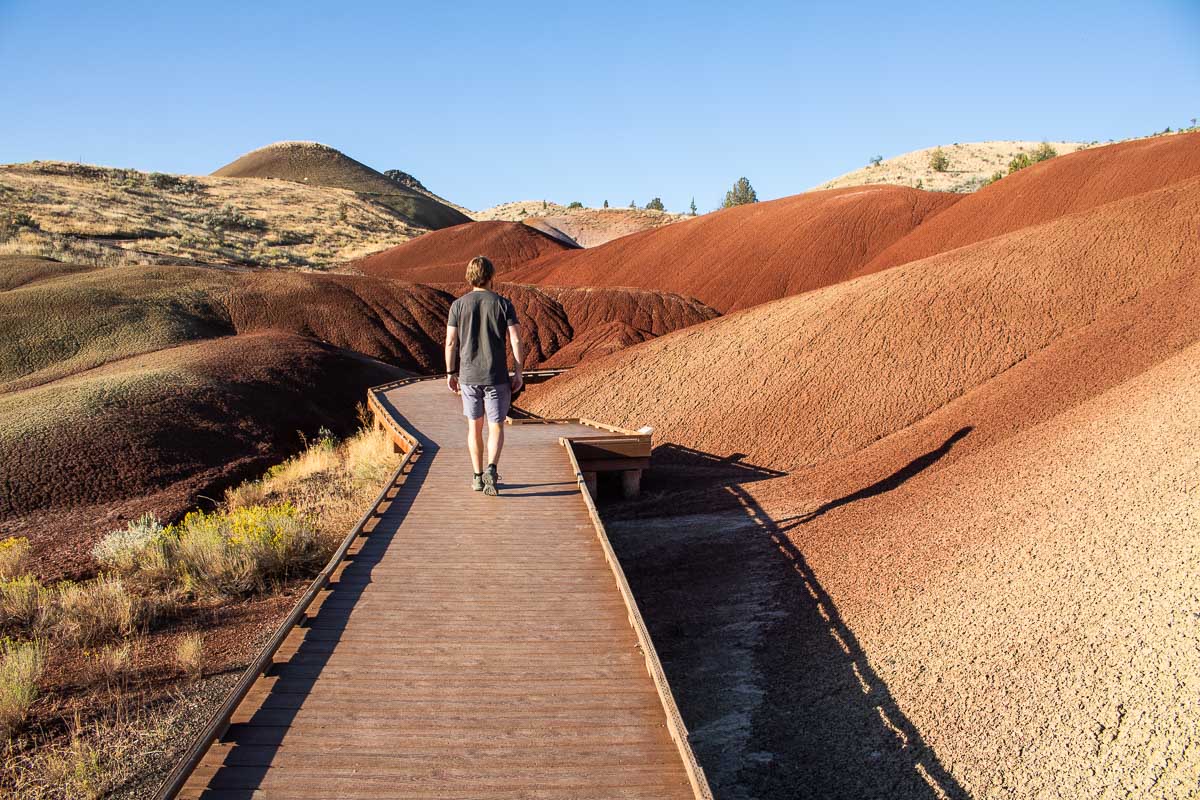
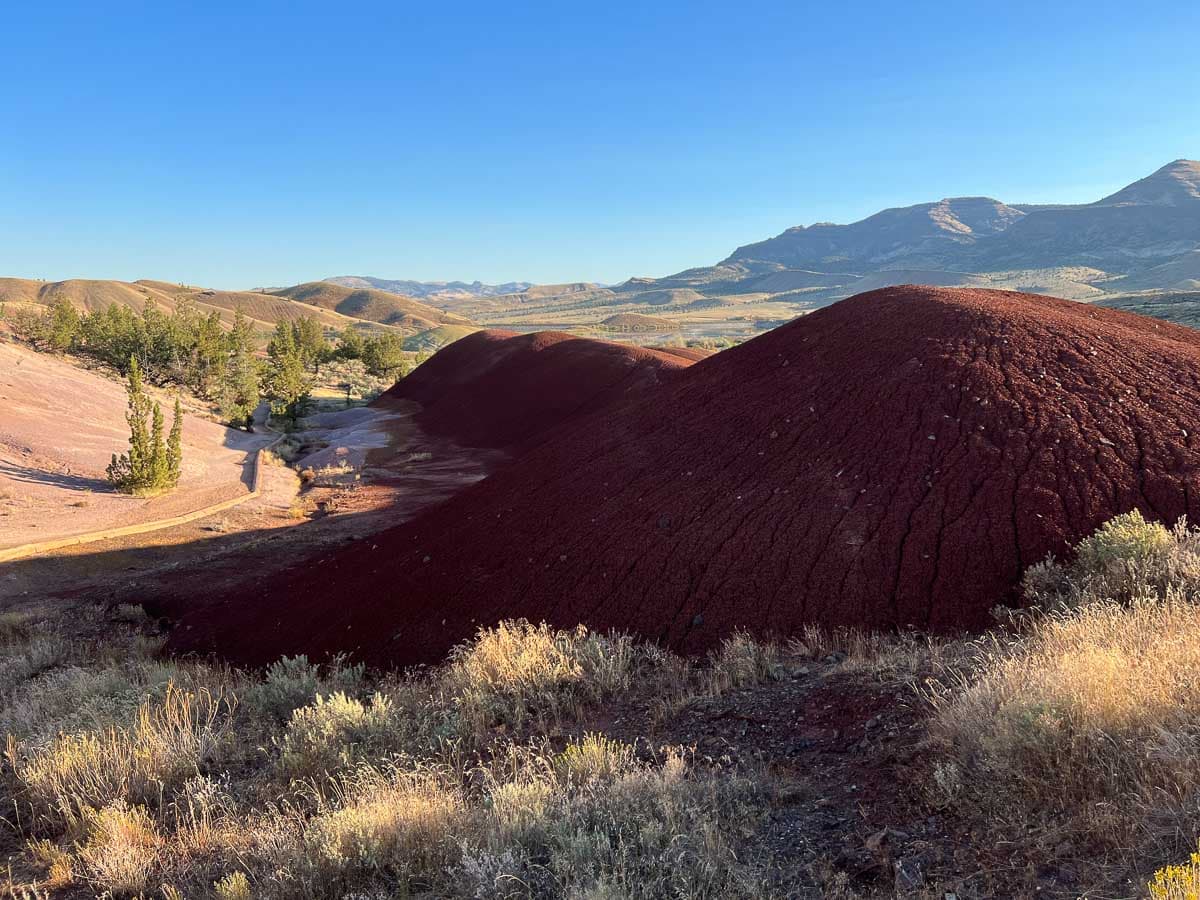
The Painted Cove Trail is an often-photographed location in the Painted Hills Unit. This easy trail—a 0.25-mile loop—includes a very short boardwalk section through vibrantly colored rocks.
It’s a super-easy walk that allows you to admire the various colors of these rocks and soils from up-close. Stay on the trail, though! Small information panels along the trail tell the story of how these colorful mounds were created.
For the brightest colors, I recommend hiking the Painted Cove Trail just after sunrise or right before sunset.
4. Walk the Leaf Hill Trail
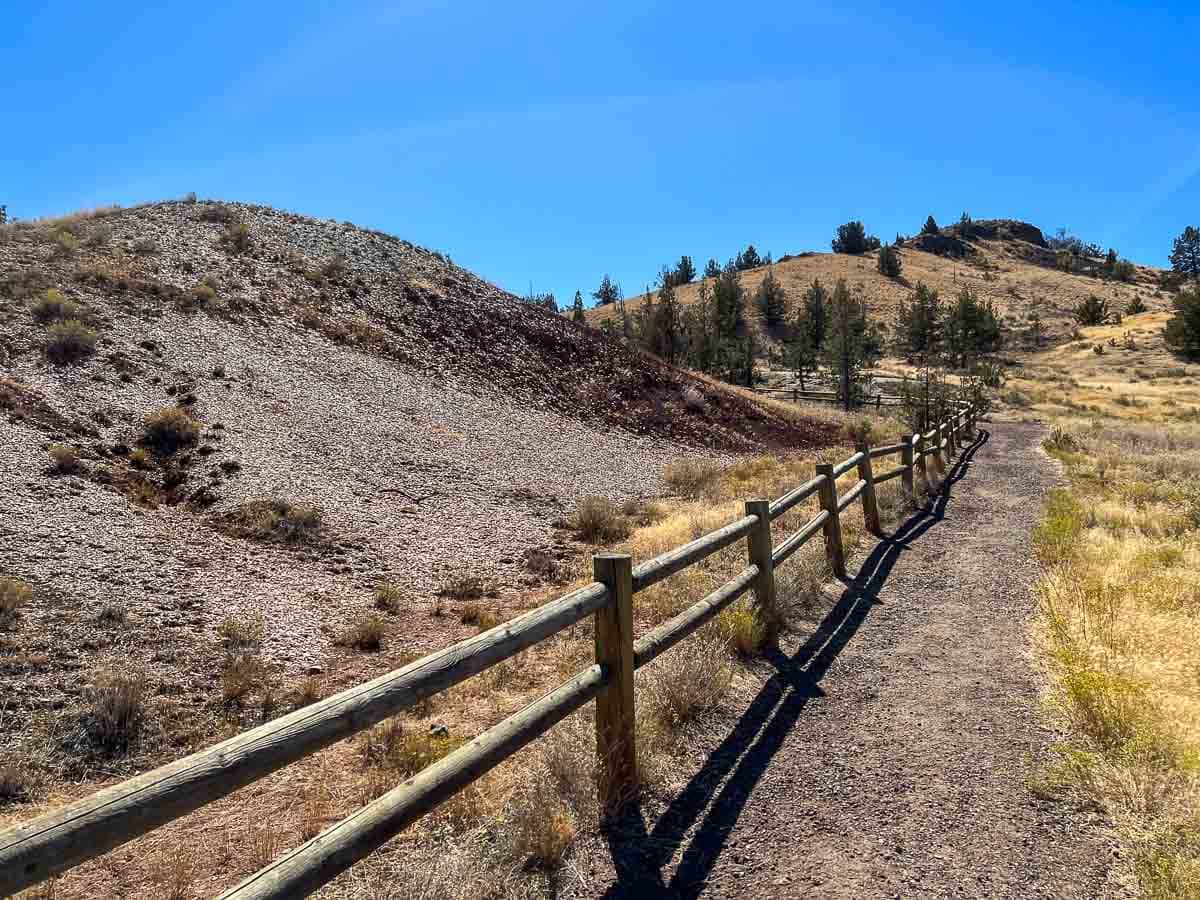
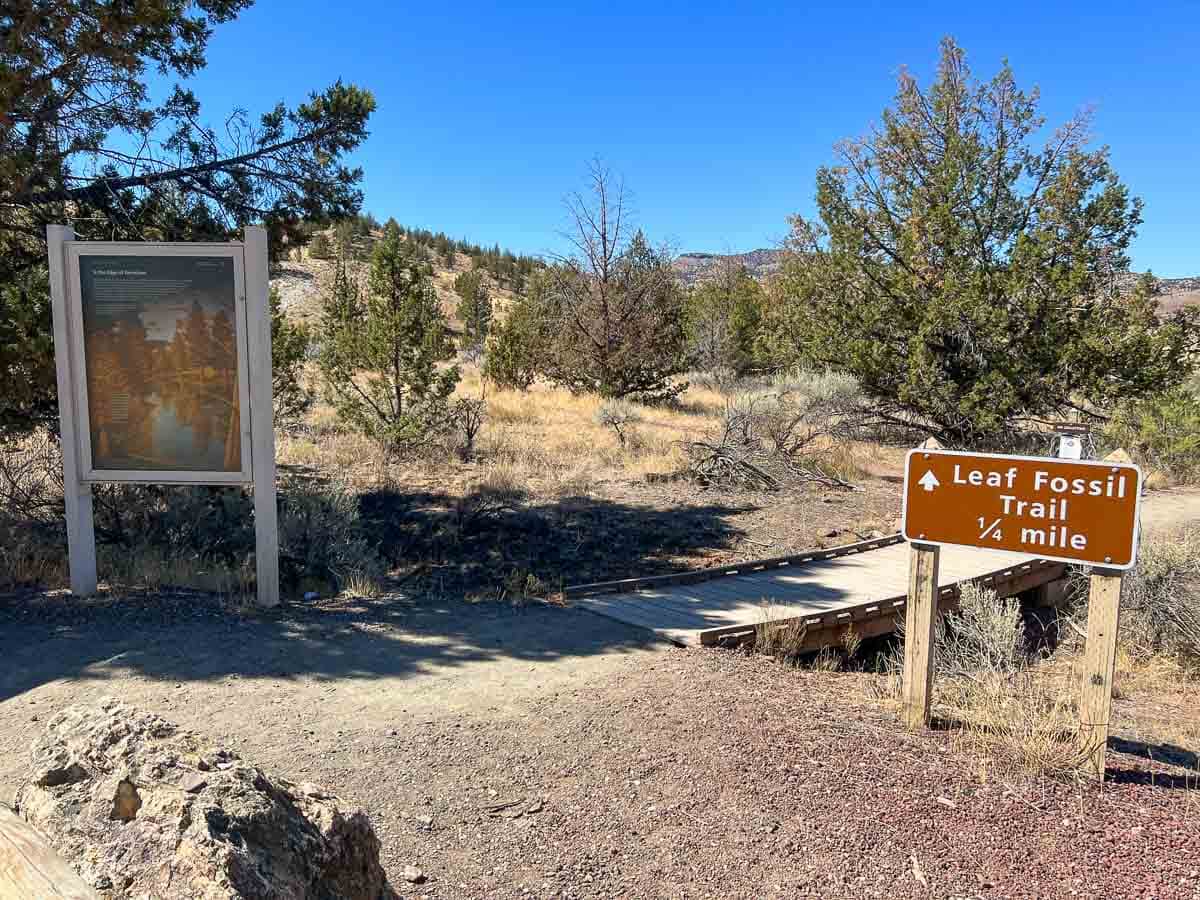
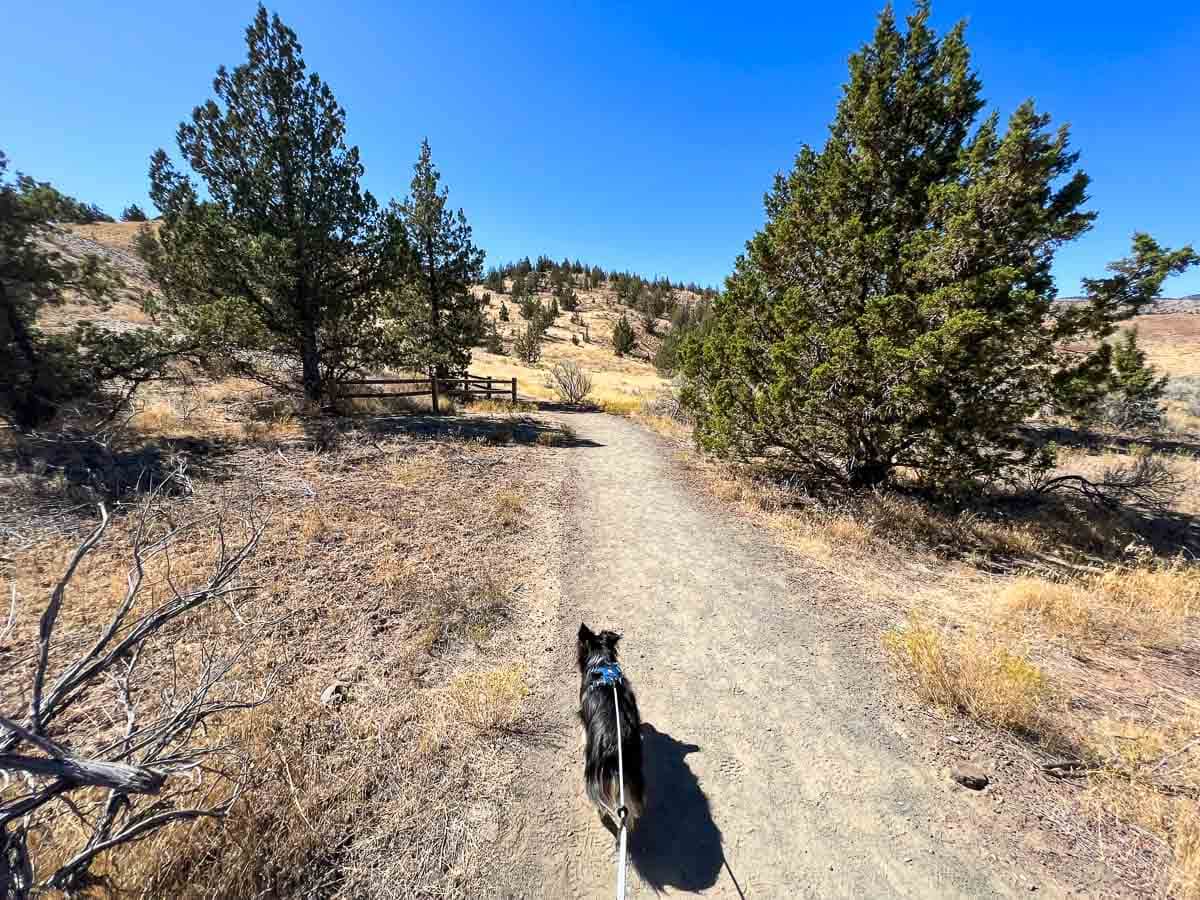
The highlight of the Leaf Hill Trail (also known as the Leaf Fossil Trail) isn’t gorgeous colors or remarkable rock formations.
Instead, this 0.25-mile loop runs around a small hill where literally thousands of fossilized leaves have been excavated—aptly called Leaf Hill.
It’s a nice little walk without any elevation gain whatsoever. Don’t skip it—it’s essentially to the overall story of the Painted Hills and John Day Fossil Beds National Monument.
Information signs at the trailhead and along the trail itself explain the history of Leaf Hill in more detail.
NOTE: The ancient soils of the Painted Hills Unit, like elsewhere in John Day Fossil Beds National Monument, contain a mindboggling wealth of fossils. It isn’t uncommon for visitors to stumble upon a fossil while hiking one of the Painted Hills trails, but please know that collecting, digging for, or disturbing any fossils is prohibited by federal law. If you find a fossil, however small it may be, take a picture of it and report it to a park ranger.
5. Take a Stroll to Red Scar Knoll
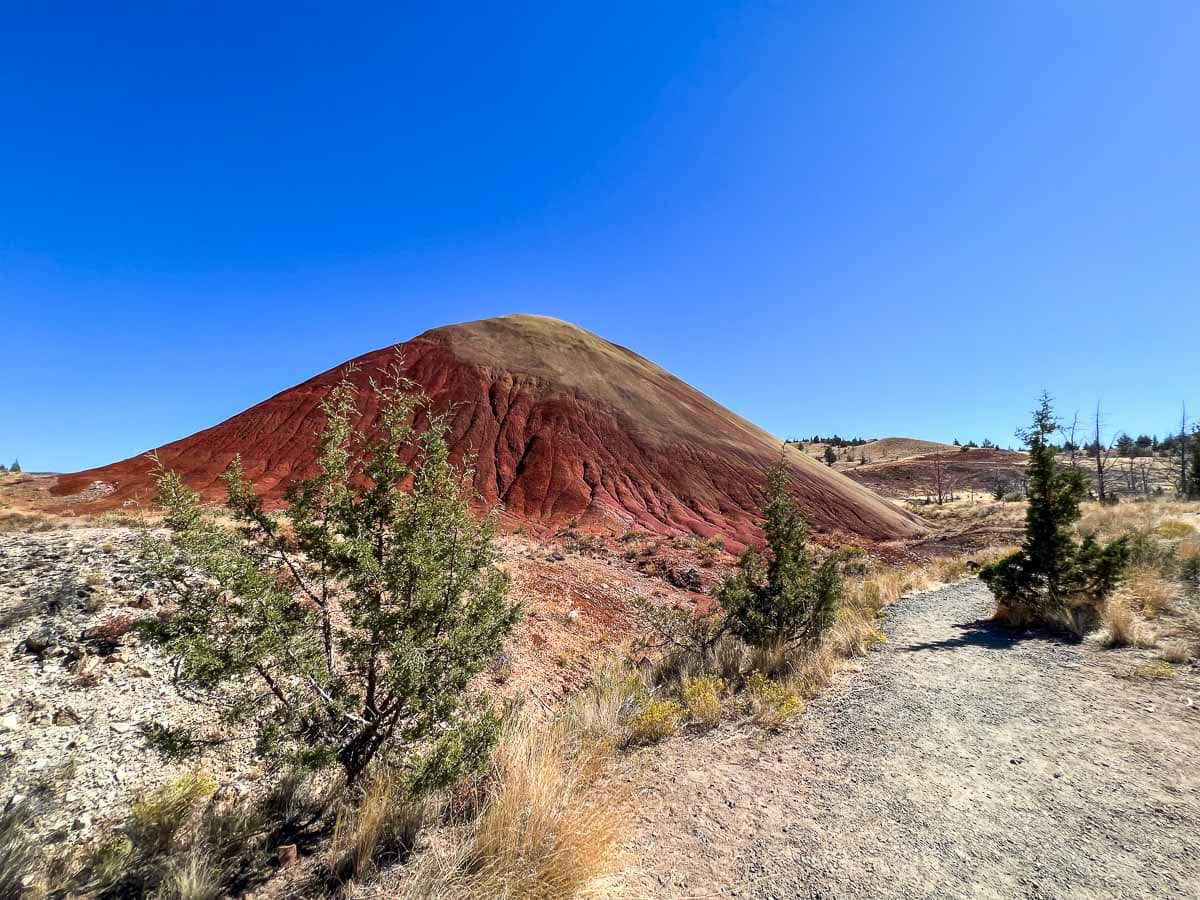
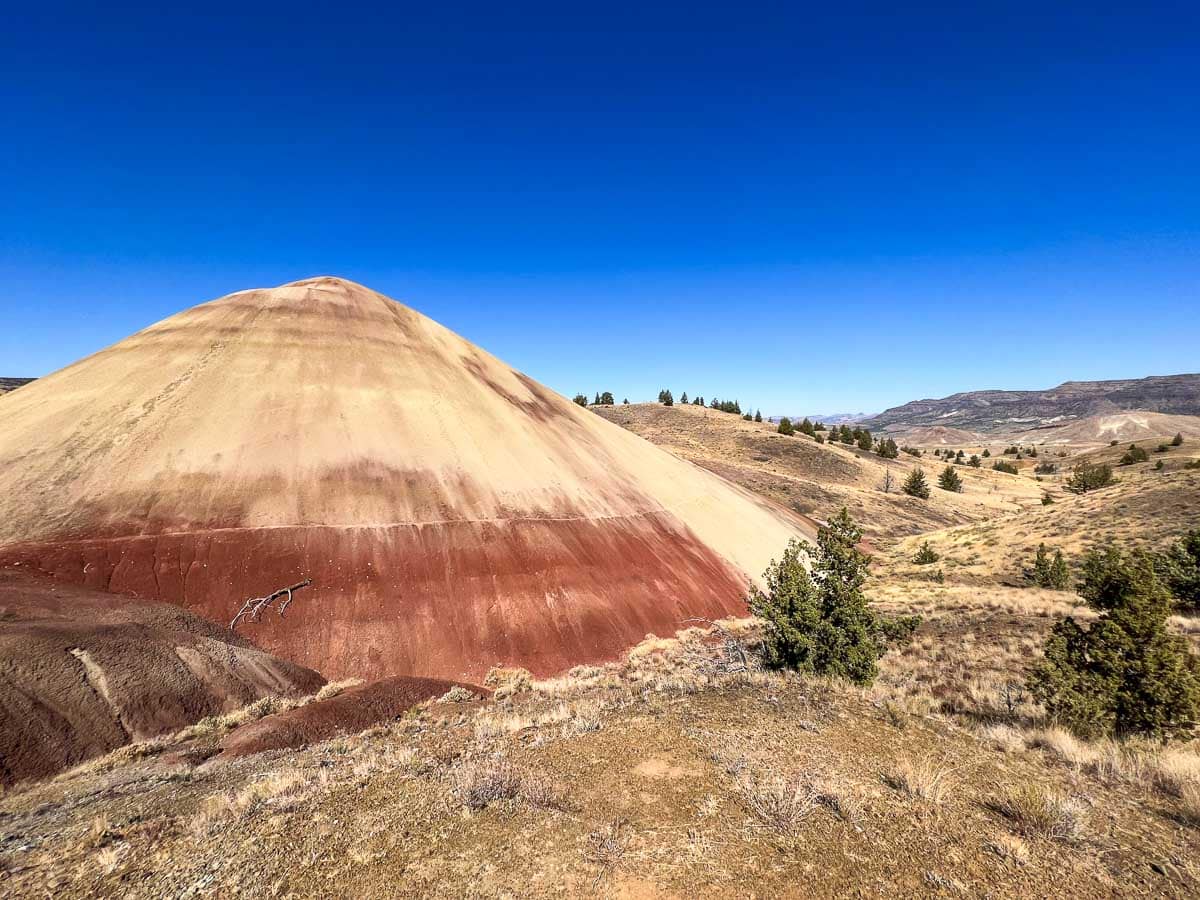
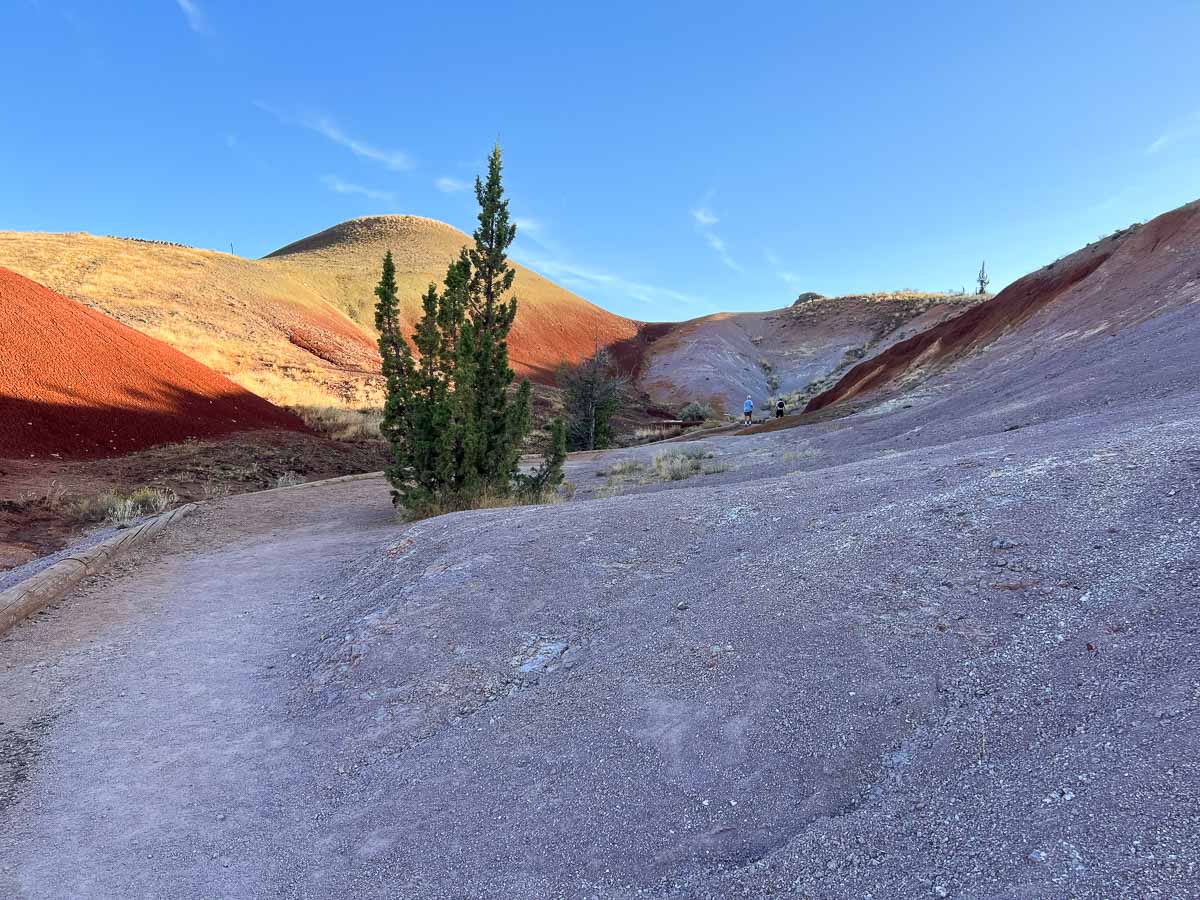
Red Scar Knoll seems a somewhat overlooked part of the Painted Hills Unit. Maybe that’s because it’s at the far end of Bear Creek Road, while many visitors tend to congregate at the Painted Hills themselves. It is definitely worth visiting, though.
Also referred to as the Red Hill Trail, the Red Scar Knoll Trail is a 0.25-mile out-and-back hike to a strikingly colorful hill made up of yellow and red clays.
What’s also interesting is that Red Scar Knoll sits in an arid landscape of dry grassy slopes and ridges—a scene that few people would associate with Oregon.
6. Hike the Carroll Rim Trail For Epic Panoramic Views
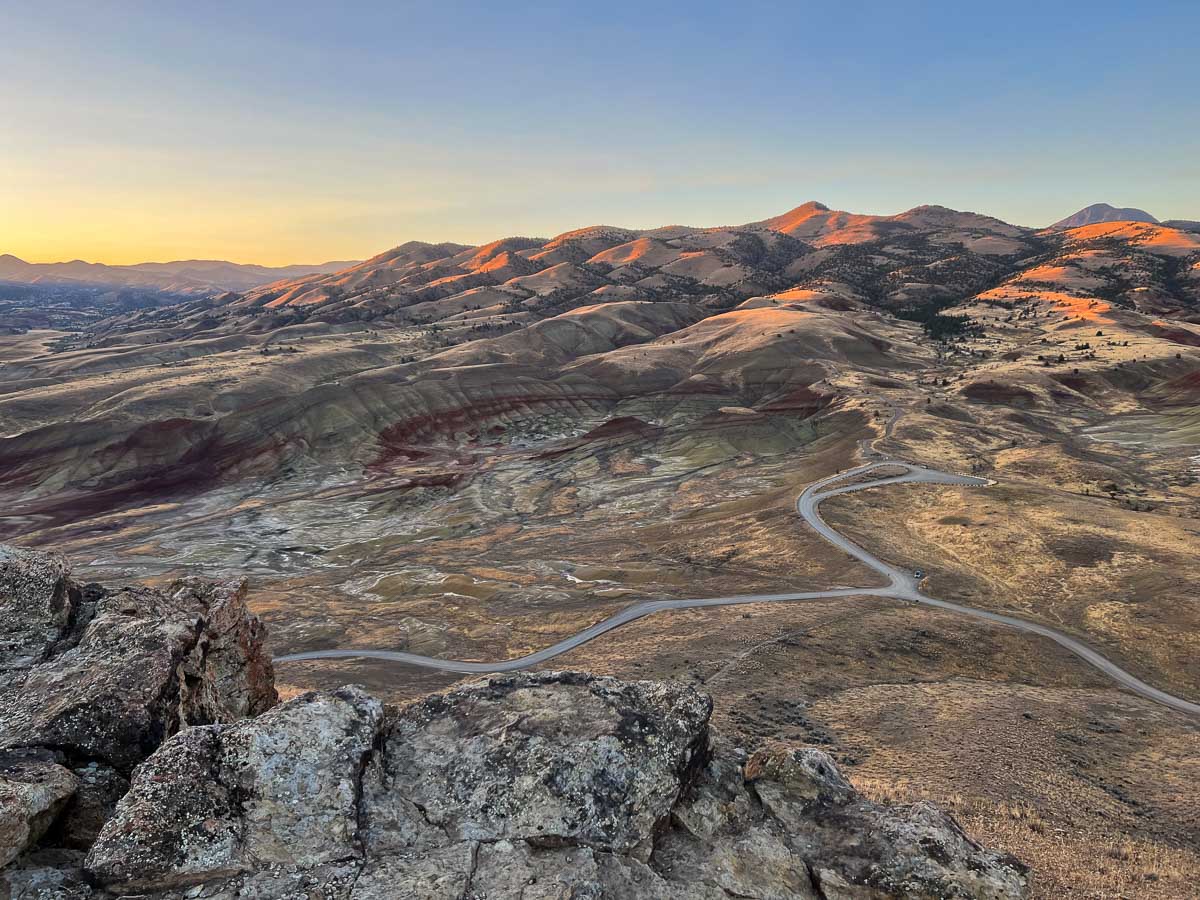
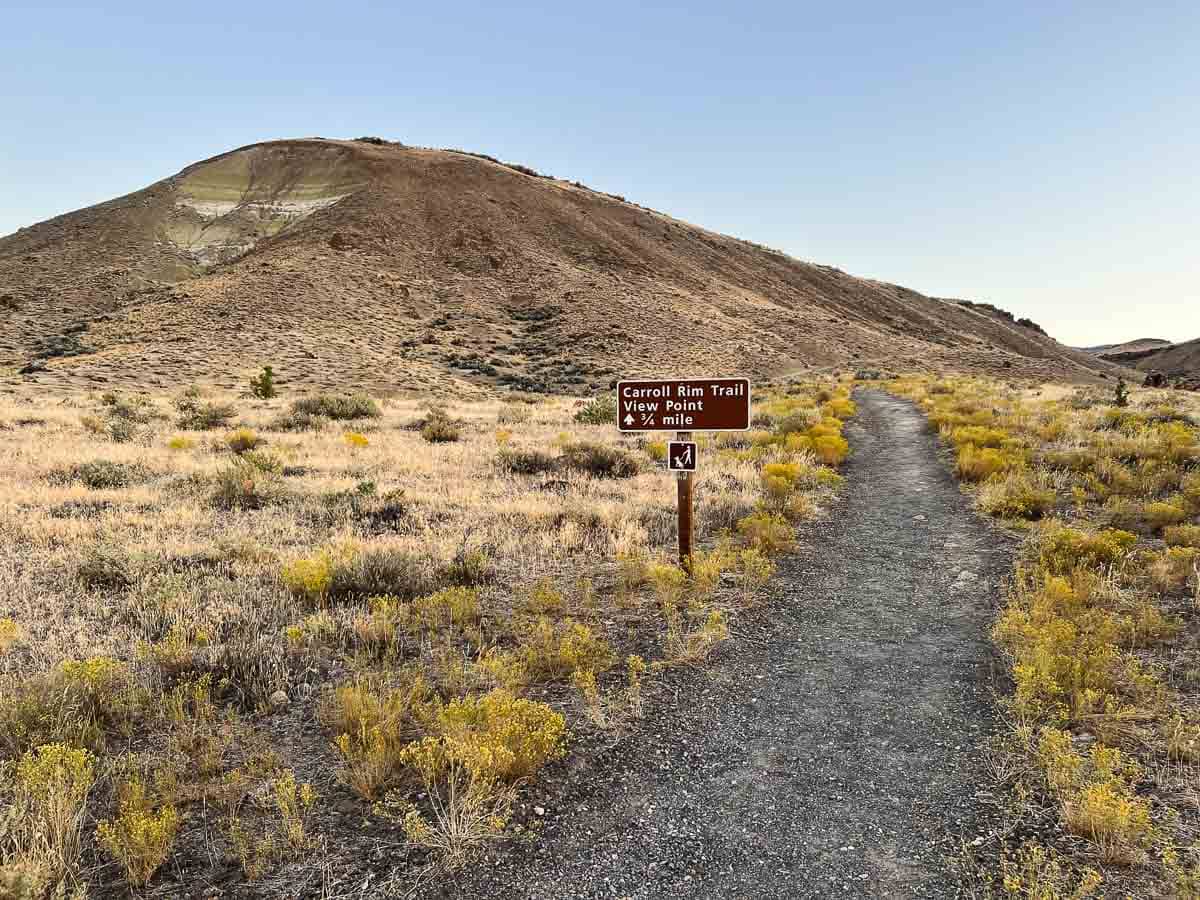
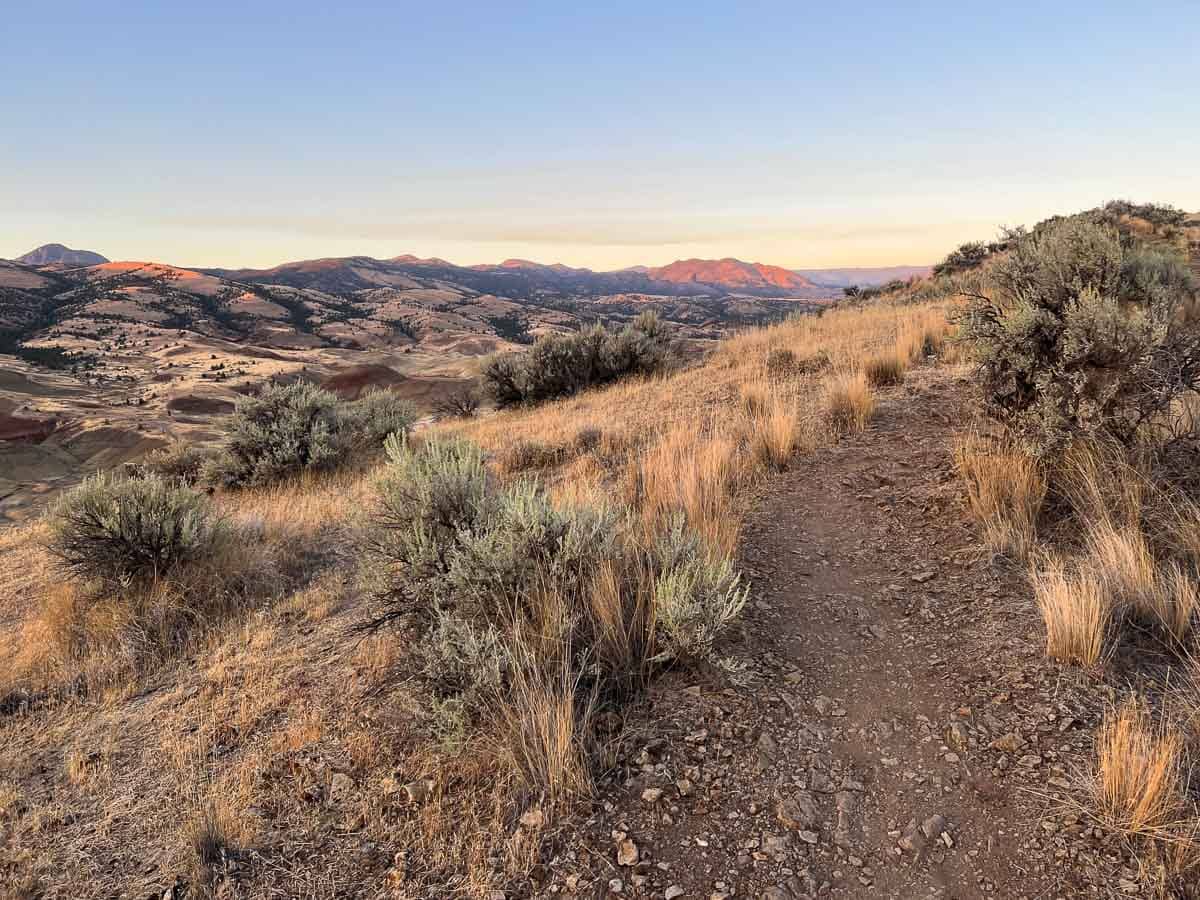
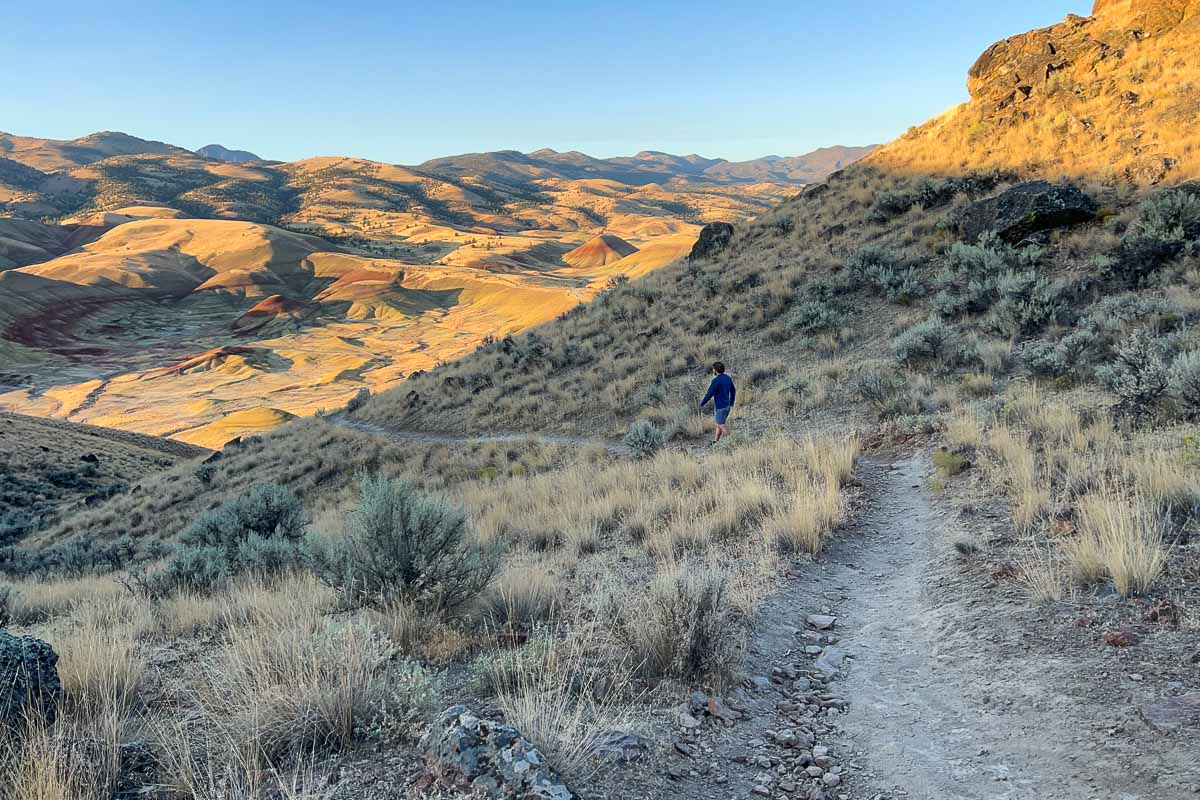
Of all these amazing things to do at the Painted Hills of Oregon, the Carroll Rim Trail has to be the best.
At 1.6 miles roundtrip, it’s the longest trail in the Painted Hills Unit and one of the longest in the entire national monument.
The trailhead is well-marked on Bear Creek Road, at the turnoff to the Painted Hills Overlook Trail.
The Carroll Rim Trail ascends a hill across from the Painted Hills themselves, eventually swinging left and along an exposed ridge.
From this ridge, the panoramic view of the Painted Hills is absolutely sensational. It’s almost a bird’s-eye view of these famous hills, which is particularly stunning at sunrise or sunset.
Like all other Painted Hills hiking trails, however, this one is also very exposed and provides little to no shade. I therefore recommend hiking it early in the morning or in the evening.
I cannot stress how spectacular this trail is. Don’t miss this one!
7. Visit the Painted Hills at Sunrise/Sunset
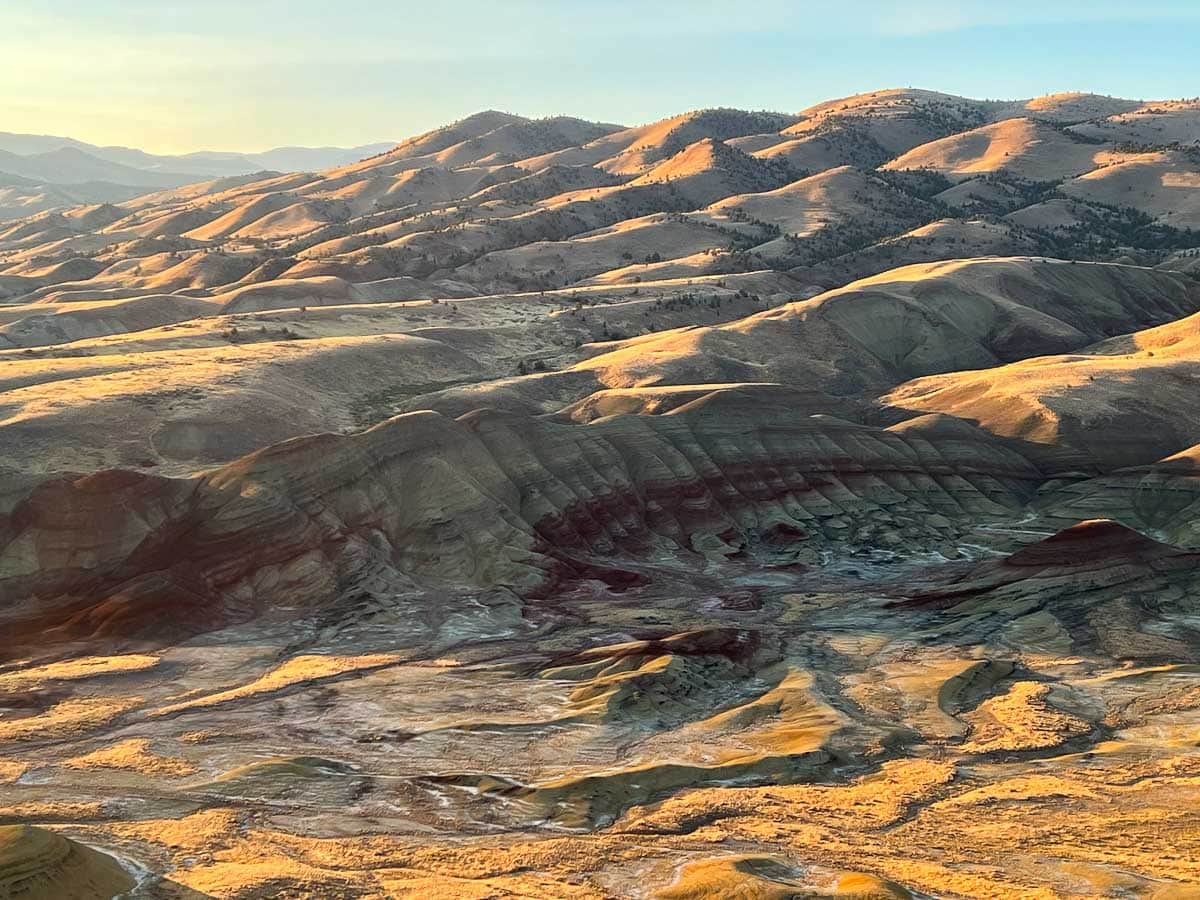
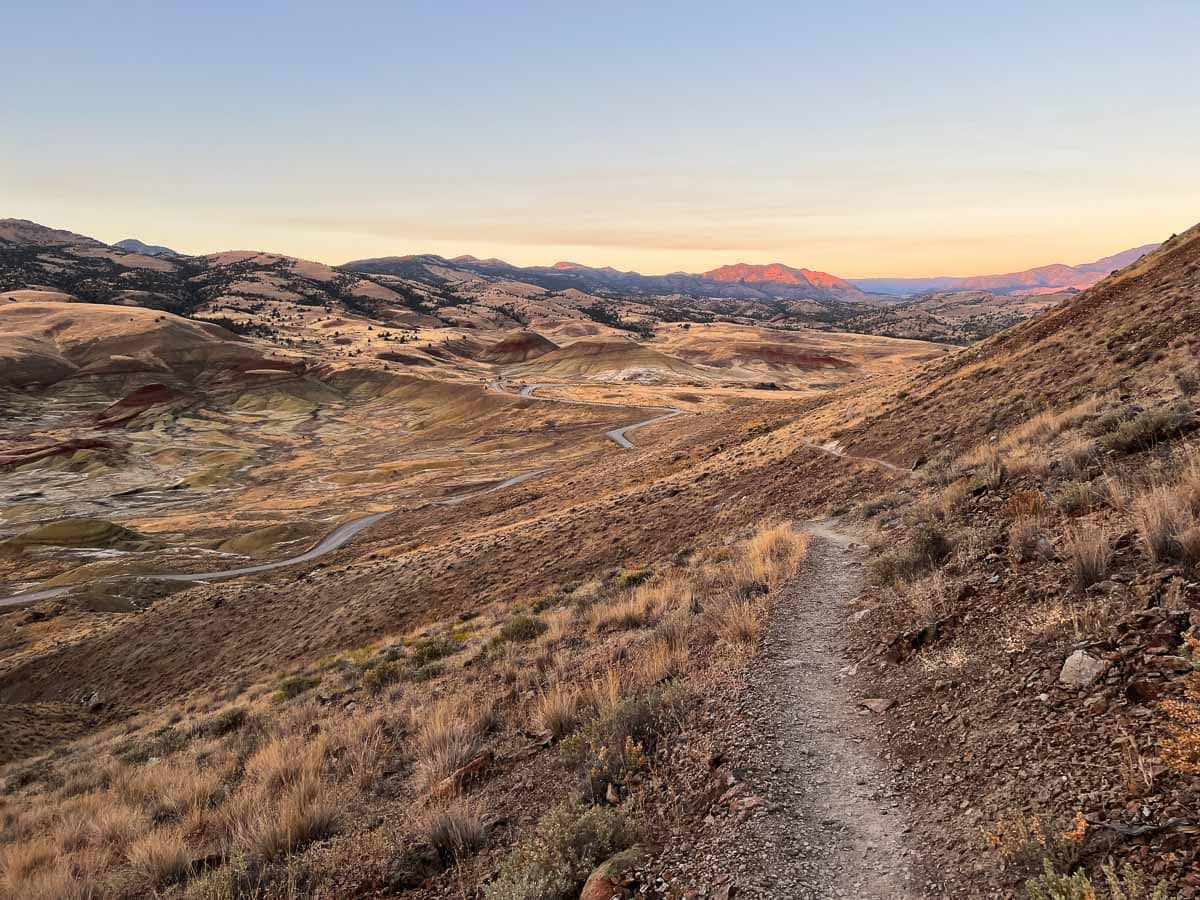
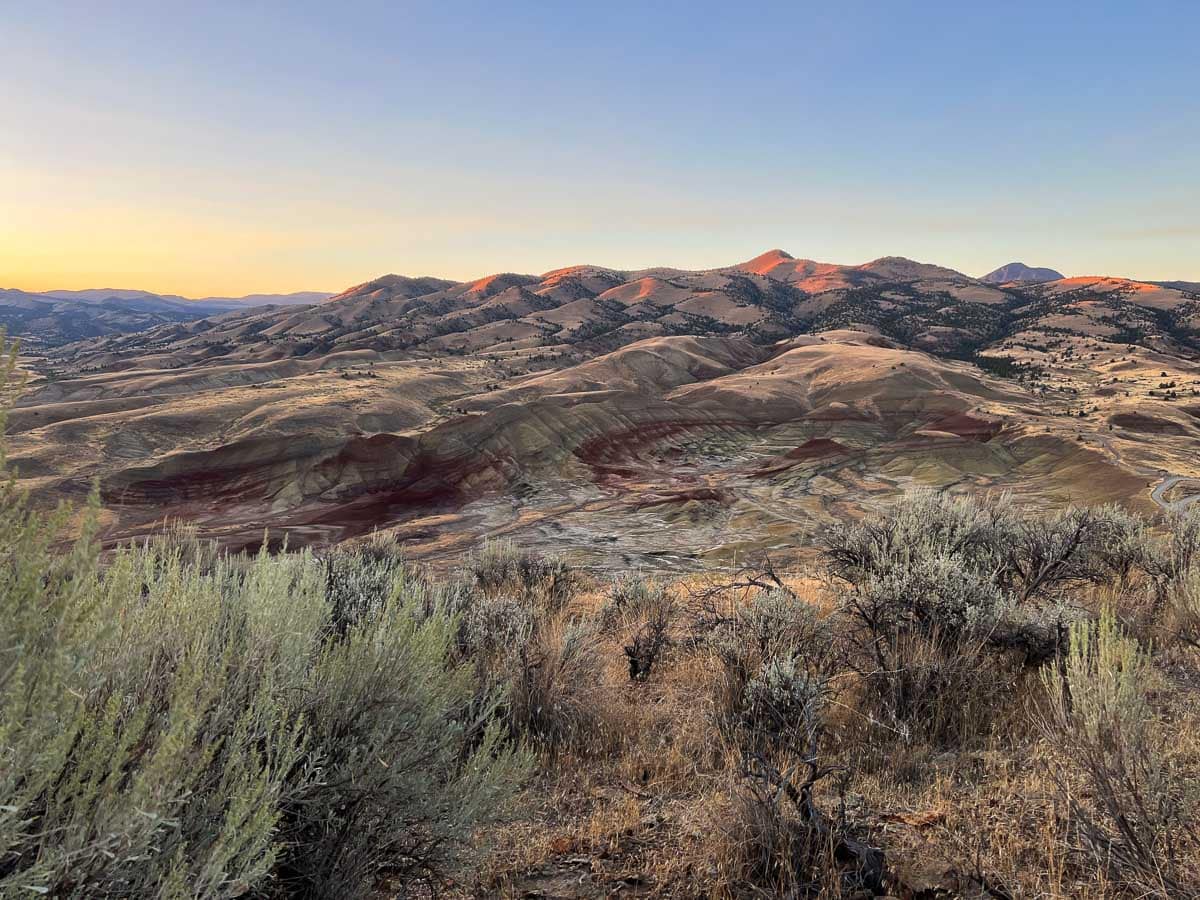
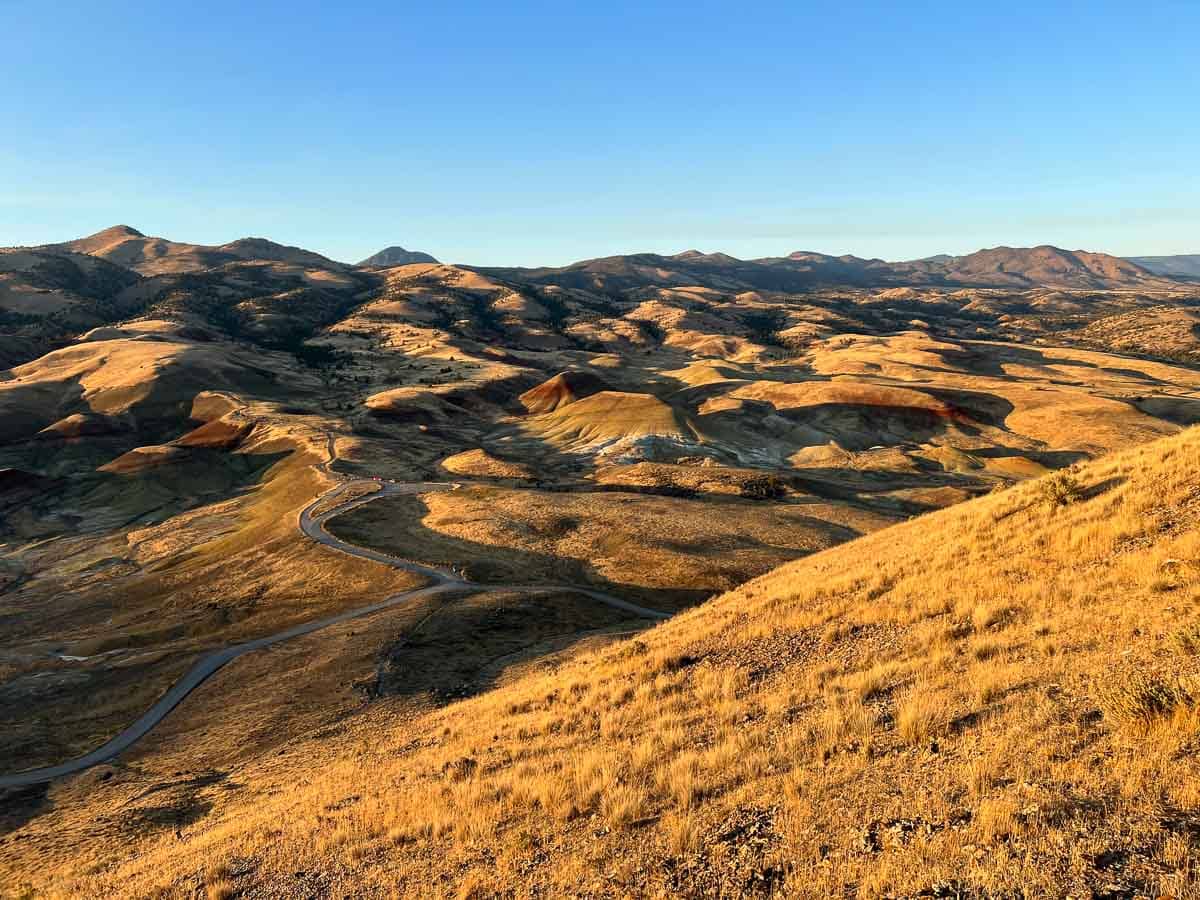
I’ve mentioned it several times above, but I’ll say it again: the best times to visit the Painted Hills are at sunrise or sunset.
Watching the sun climb above the ridges to the east, slowly painting shadows across this marvelous, ancient landscape, is an almost spiritual experience. The Carroll Rim Trail offers the best vantage point.
Sunset, on the other hand, is best enjoyed from the Painted Hills Overlook Trail.

BONUS ACTIVITY: STARGAZING
Because of their remote location far from large towns or cities, the Painted Hills don’t have any light pollution. This is a place where you can still enjoy an ancient night sky, peppered with thousands of stars. The Painted Hills Overlook Trail is an excellent place to watch the Milky Way sparkle above these iconic hills.
Hiking Trail Map of the Painted Hills Unit (John Day Fossil Beds National Monument)
This National Park Service map shows all the hiking trails at the Painted Hills Unit of John Day Fossil Beds National Monument.
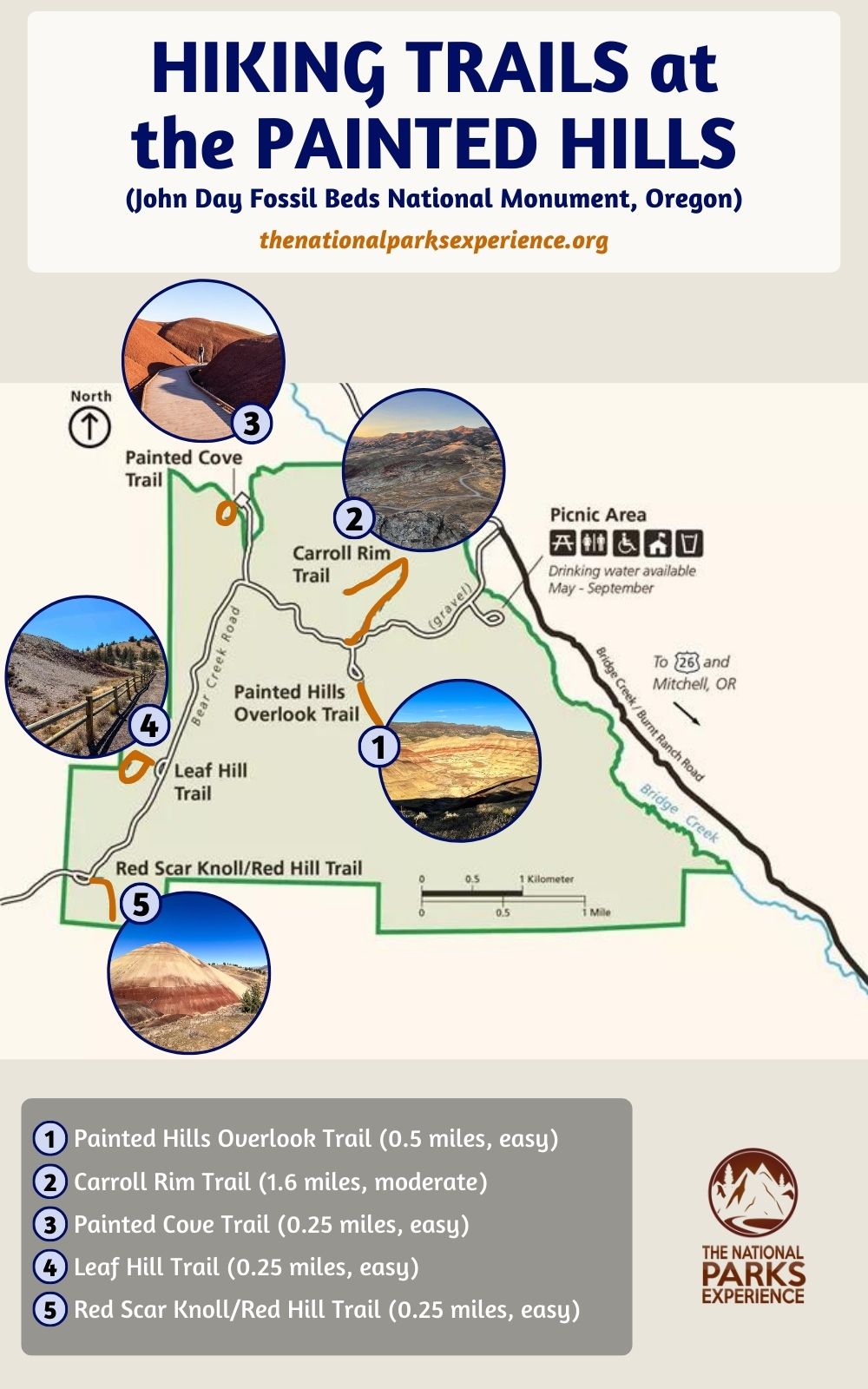
More National Parks in the Pacific Northwest
- Best Views in Crater Lake National Park, Oregon
- Top Day Hikes in Mount Rainier National Park, Washington
- Guide to the Wildflowers of Mount Rainier National Park, Washington
- What to Do at Lake Quinault in Olympic National Park, Washington
- Top Things to Do in North Cascades National Park, Washington
- The Ultimate Pacific Northwest National Parks Road Trip Itinerary
